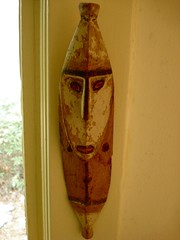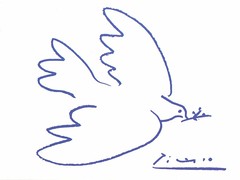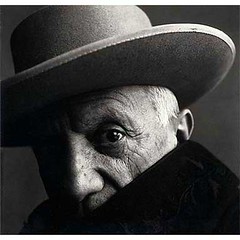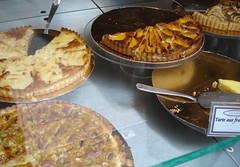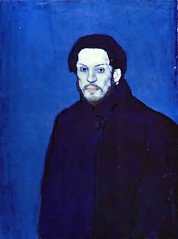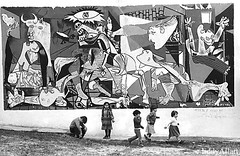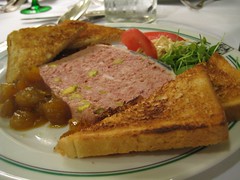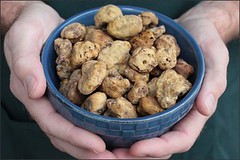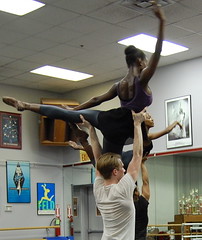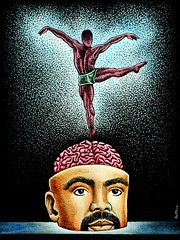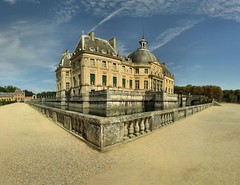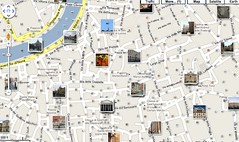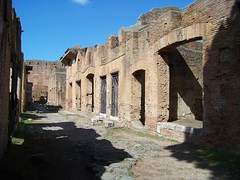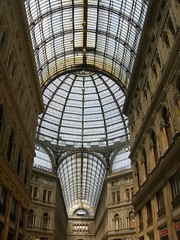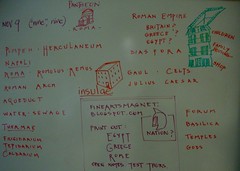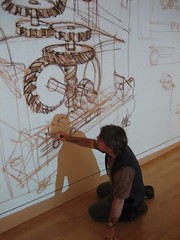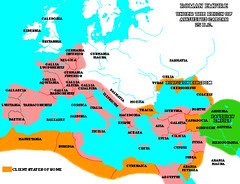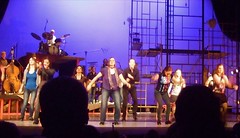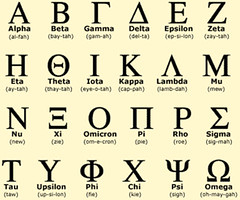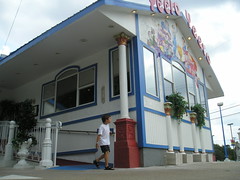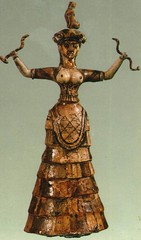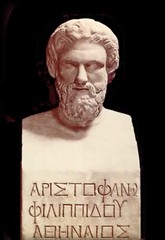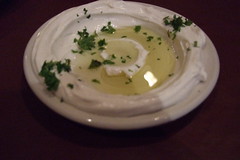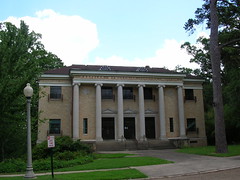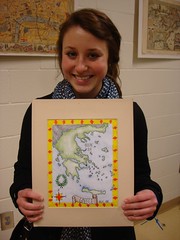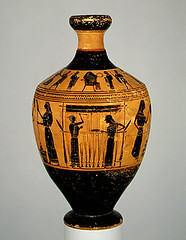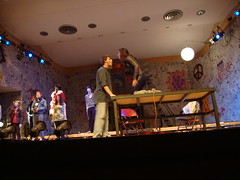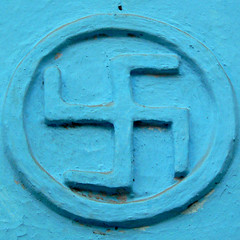Old questions from quizzes on this, the class blog, will form the basis for an 80 question test in the fine arts exam.
- Open notes.
- Multiple choice.
- Some questions will be presented verbatim and some will be tweaked.
20 pts will be given to a comparison essay. Students must assemble the research on the topics and write the notes in advance of the exam. The final draft of the essay will be written during the exam period.
Topic choices:
- Societies in which art was pervasive and expert in execution: the Egyptians and the Greeks.
- Artistic and classic style in expression / the parallels between communication through photography and through prose.
- The arts of Jazz and dance: comparing personalities and techniques in the related fields of hot music and hot movement
Wednesday, December 15, 2010
African masks influenced Picasso, Matisse and other modernists
In the early 20th century, African artifacts were being brought back to Paris museums in consequence of the expansion of the French empire into Africa, says Wikipedia.
The press was abuzz with exaggerated stories of cannibalism and exotic tales about the African kingdom of Dahomey. The mistreatment of Africans in the Belgian Congo was exposed in Joseph Conrad's popular book, Heart of Darkness.
It was natural in this climate of African interest that Picasso would look towards African artifacts as inspiration for some of his work; his interest was sparked by Henri Matisse who showed him a mask from the Dan region of Africa.[2]
In May or June 1907, Picasso experienced a "revelation" while viewing African art at the ethnographic museum at Palais du Trocadéro.[3] Picasso's discovery of African art influenced the style of his painting Les Demoiselles d'Avignon (begun in May 1907 and reworked in July of that year), especially in the treatment of the two figures on the right side of the composition.
Although Les Demoiselles is seen as the first Cubist work, Picasso continued to develop a style derived from African art before beginning the Analytic Cubism phase of his painting in 1910.
Other works of Picasso's African Period include the Bust of a Woman (1907, in the National Gallery, Prague); Mother and Child (Summer 1907, in the Musée Picasso, Paris); Nude with Raised Arms (1907, in the Thyssen-Bornemisza Museum, Lugano, Switzerland); and Three Woman (Summer 1908, in the Hermitage Museum, St. Petersburg).
The press was abuzz with exaggerated stories of cannibalism and exotic tales about the African kingdom of Dahomey. The mistreatment of Africans in the Belgian Congo was exposed in Joseph Conrad's popular book, Heart of Darkness.
It was natural in this climate of African interest that Picasso would look towards African artifacts as inspiration for some of his work; his interest was sparked by Henri Matisse who showed him a mask from the Dan region of Africa.[2]
In May or June 1907, Picasso experienced a "revelation" while viewing African art at the ethnographic museum at Palais du Trocadéro.[3] Picasso's discovery of African art influenced the style of his painting Les Demoiselles d'Avignon (begun in May 1907 and reworked in July of that year), especially in the treatment of the two figures on the right side of the composition.
Although Les Demoiselles is seen as the first Cubist work, Picasso continued to develop a style derived from African art before beginning the Analytic Cubism phase of his painting in 1910.
Other works of Picasso's African Period include the Bust of a Woman (1907, in the National Gallery, Prague); Mother and Child (Summer 1907, in the Musée Picasso, Paris); Nude with Raised Arms (1907, in the Thyssen-Bornemisza Museum, Lugano, Switzerland); and Three Woman (Summer 1908, in the Hermitage Museum, St. Petersburg).
Tuesday, December 14, 2010
Essay comparing Picasso & Steve Jobs
In-class comparison essay on Th:
compare the technology-changing Steve Jobs to the art-changing Pablo Picasso. Bring your notes on Picasso. I will supply the note on Jobs and Apple.
The dove of peace and Picasso:
Picasso's last daughter is named Paloma. That means "dove," an animal which was an important image for the artist. "Picasso donated the dove of peace sketch to the Soviet backed World Peace Congress of 1949. It was rather sad that the Stalinist ideology of Communism betrayed the aspirations of peace loving Socialists like Picasso," says biographyonline.com.
Says Wikipedia:
"Picasso's lithograph, La Colombe (The Dove), a traditional, realistic picture of a pigeon, was chosen as the emblem for the World Peace Congress in Paris in April 1949. The dove became a symbol for the peace movement and the ideals of the Communist Party and was used in Communist demonstrations of the period. At the 1950 World Peace Congress in Sheffield, Picasso said that his father had taught him to paint doves, concluding, "I stand for life against death; I stand for peace against war."[13][14]"
As Fine Arts Survey knows from the John Richardson bio, Picasso learned from his dad how to draw pigeons.
Close enough, right?
compare the technology-changing Steve Jobs to the art-changing Pablo Picasso. Bring your notes on Picasso. I will supply the note on Jobs and Apple.
The dove of peace and Picasso:
Picasso's last daughter is named Paloma. That means "dove," an animal which was an important image for the artist. "Picasso donated the dove of peace sketch to the Soviet backed World Peace Congress of 1949. It was rather sad that the Stalinist ideology of Communism betrayed the aspirations of peace loving Socialists like Picasso," says biographyonline.com.
Says Wikipedia:
"Picasso's lithograph, La Colombe (The Dove), a traditional, realistic picture of a pigeon, was chosen as the emblem for the World Peace Congress in Paris in April 1949. The dove became a symbol for the peace movement and the ideals of the Communist Party and was used in Communist demonstrations of the period. At the 1950 World Peace Congress in Sheffield, Picasso said that his father had taught him to paint doves, concluding, "I stand for life against death; I stand for peace against war."[13][14]"
As Fine Arts Survey knows from the John Richardson bio, Picasso learned from his dad how to draw pigeons.
Close enough, right?
Picasso, Pablo (1881-1973) - 1907 Les Demoiselles d' Avignon (Museum of Modern Art, New York City)

Picasso, Pablo (1881-1973) - 1907 Les Demoiselles d' Avignon (Museum of Modern Art, New York City)
Originally uploaded by RasMarley
among his most famous works are the proto-Cubist Les Demoiselles d'Avignon (1907) and Guernica (1937), his portrayal of the German bombing of Guernica during the Spanish Civil War.
This 1907 masterpiece by Picasso is the first great piece of cubist art. The influence of African masks is obvious, especially in the two figures on the right.
Notes from Wikipedia -
- Picasso was married twice and had four children by three women. He had a never-ending series of lovers - ex. Dora Maar - in addition to wives and principal mistresses.
-He was publicly a Communist - from the late 1940's. Yet one would argue that he was apolitical: he remained neutral during World War I, the Spanish Civil War, and World War II, refusing to fight for any side or country.
- During the Second World War, Picasso remained in Paris while the Germans occupied the city.
- After the war he became famous and wealthy (ex: the 1946 retrospective show at MoMa). He moved permanently to Provence, near the Med. The last 12 years he lived in the small town of Mougins, near the famous beach resort of Cannes.
- The climate is Mediterranean and the city enjoys 12 hours of sunshine per day during summer (May to September), while in winter (December to February) the weather is mild. Both seasons see a relatively low rainfall and most rain is during October and November, when 110 mm falls.
- Mougins has been frequented and inhabited by many artists and celebrities, including Pablo Picasso, Jean Cocteau, Fernand Léger, Francis Picabia, Man Ray, Yves Klein, Yves Saint Laurent, Christian Dior, Winston Churchill, Catherine Deneuve, Édith Piaf.
- The region of Mougins - Provence - has been home to artists such as Henri Matisse,Vincent Van Gogh, Paul Cezanne, Auguste Renoir, Pierre Bonnard and Claude Monet.
Misogyny and machismo - hatred of women and exaggerated sense of maleness, were both part of the Spanish nature of Picasso.
Monday, December 13, 2010
Pablo Picasso,1957
A review of the PIcasso bio -
1. Like Lennon & McCartney, Pablo Picasso was competitive with his peers. He both worked with and in an effort to top fellows like:
a) Jackson Pollock b) Henri Matise c) Chuck Close d) Richard Serra.
2. Picasso would have served you a supper of a) tortellini b) sauerkraut c) mughal curry d) paella.
3. The Spanish peninsula was occupied by the Romans and, later, by the North African Moors. The peninsula is called a) Apulia b) Iberia
c) Anatolia d) Barcelona.
4. Seville, Cordova, Granada: these are the Moorish cities of Spain's southern region. It is known as a) Andalusia b) Navarre c) Valencia d) Aragon.
5. The region of Paris historically notable for pimps, eccentrics, anarchists, students and artists: a) Bastille b) le Louvre c) Montmartre d) Champs Elysees.
6. In stage production the Harlequin is the hungry, lecherous and acrobatic
a) buffoon b) protagonist c) antagonist d) heroine.
7. Which order of production is correct? a) opium>morphine>heroin b) heroin>opium>morphine c) morphine>opium>heroin.
8. Les Demoiselles d'Avignon were a group of young women in a brothel in a) Madrid b) Paris c) Barcelona d) Malaga.
9. We can see that Picasso saw himself as a shaman, an intermediary between the human and spirit worlds, by his display of influence from a) surrealism b) cubism c) Africa d) mythology.
10. Chinese influence in Paris: a) Lapin Agile b) Les Deux Magots c) Harlequins d) opium.
11. This figure dwelled at the heart of the Cretan labyrinth: a) Harlequin b) minotaur c) Alhambra d) Odysseus.
12. The Spanish Civil War featured a Fascist force versus an anti-government rebel force. T / F
13. Gynophobia: a) fear of exercise b) fear of witches c) fear of female physicians d) fear of women.
14. Exaggerated male attitude: a) machismo b) pacifism c) misogyny d) fascism.
15. Religious Society of Friends (Quakers), Amish, Mennonites:
a) machismo b) pacifism c) misogyny d) fascism.
16. Mapping the life of Picasso: 1. Malaga 2. Barcelona 3. ___ 4. Paris 17. Provence region and Cote d'Azur of France.
a) London b) Valencia c) Marseille d) Seville.
18. In Paris, one of Picasso's most frequent destinations was the
a) Louvre b) Tour Eiffel c) Notre Dame de Paris d) River Seine
1. Like Lennon & McCartney, Pablo Picasso was competitive with his peers. He both worked with and in an effort to top fellows like:
a) Jackson Pollock b) Henri Matise c) Chuck Close d) Richard Serra.
2. Picasso would have served you a supper of a) tortellini b) sauerkraut c) mughal curry d) paella.
3. The Spanish peninsula was occupied by the Romans and, later, by the North African Moors. The peninsula is called a) Apulia b) Iberia
c) Anatolia d) Barcelona.
4. Seville, Cordova, Granada: these are the Moorish cities of Spain's southern region. It is known as a) Andalusia b) Navarre c) Valencia d) Aragon.
5. The region of Paris historically notable for pimps, eccentrics, anarchists, students and artists: a) Bastille b) le Louvre c) Montmartre d) Champs Elysees.
6. In stage production the Harlequin is the hungry, lecherous and acrobatic
a) buffoon b) protagonist c) antagonist d) heroine.
7. Which order of production is correct? a) opium>morphine>heroin b) heroin>opium>morphine c) morphine>opium>heroin.
8. Les Demoiselles d'Avignon were a group of young women in a brothel in a) Madrid b) Paris c) Barcelona d) Malaga.
9. We can see that Picasso saw himself as a shaman, an intermediary between the human and spirit worlds, by his display of influence from a) surrealism b) cubism c) Africa d) mythology.
10. Chinese influence in Paris: a) Lapin Agile b) Les Deux Magots c) Harlequins d) opium.
11. This figure dwelled at the heart of the Cretan labyrinth: a) Harlequin b) minotaur c) Alhambra d) Odysseus.
12. The Spanish Civil War featured a Fascist force versus an anti-government rebel force. T / F
13. Gynophobia: a) fear of exercise b) fear of witches c) fear of female physicians d) fear of women.
14. Exaggerated male attitude: a) machismo b) pacifism c) misogyny d) fascism.
15. Religious Society of Friends (Quakers), Amish, Mennonites:
a) machismo b) pacifism c) misogyny d) fascism.
16. Mapping the life of Picasso: 1. Malaga 2. Barcelona 3. ___ 4. Paris 17. Provence region and Cote d'Azur of France.
a) London b) Valencia c) Marseille d) Seville.
18. In Paris, one of Picasso's most frequent destinations was the
a) Louvre b) Tour Eiffel c) Notre Dame de Paris d) River Seine
Thursday, December 9, 2010
La cuisine: the vocab of French cooking
The Fine Art of French cooking
vocab -
* Escargots Burguignon: snails served in a garlic-butter sauce.
* fromage: cheese
* brie: a type of goat cheese
* mayonnaise: sauce of olive oil, eggs, lemon, etc.
* pomme de terre frites: french fries (aka "frites")
* ecrevisses: crawfish
* boudin noir: rice-filled pork sausage - with congealed blood.
* pate de foie gras: liver paste; made of fattened goose livers.
* truffles: underground fungal plant & snob appeal food
* boeuf Burguignon: beef stew with wine
* petit dejeuner : breakfast
* dejeuner: lunch (typically, 2 hours)
* le diner: supper (2 hrs later than American supper).
* pain perdu: French toast.
* le pain: bread. a baguette is a long, thin loaf of French bread.
* quiche Lorraine: egg-cheese pie.
* Perrier: bottled, sparkling water from France.
* Bon appetit! "Good eating!"
* un apéritif - cocktail, pre-dinner drink
* le café - coffee
* un œuf, des œufs egg, eggs
* le sel salt
* le sucre sugar
* a la carte - from the menu; more expensive than ordering le prix fixe (the supper recommended by the restaurant).
* oenophile - wine connoiseur
* champagne - sparkling wine, which is twice-fermented, from the region of Champagne.
- liqueur - fortified, often fruit-flavored wines (about 40% alcohol as opposed to the 15 - 18 % of an ordinary Bordeaux), such as Amaretto (almond flavored), Grand Marnier (orange-flavored), Ouzo (licorice-flavored) and Creme de Menthe (mint-flavored).
- brandy - a strong, distilled wine; example: cognac from the Perigord region of France.
vocab -
* Escargots Burguignon: snails served in a garlic-butter sauce.
* fromage: cheese
* brie: a type of goat cheese
* mayonnaise: sauce of olive oil, eggs, lemon, etc.
* pomme de terre frites: french fries (aka "frites")
* ecrevisses: crawfish
* boudin noir: rice-filled pork sausage - with congealed blood.
* pate de foie gras: liver paste; made of fattened goose livers.
* truffles: underground fungal plant & snob appeal food
* boeuf Burguignon: beef stew with wine
* petit dejeuner : breakfast
* dejeuner: lunch (typically, 2 hours)
* le diner: supper (2 hrs later than American supper).
* pain perdu: French toast.
* le pain: bread. a baguette is a long, thin loaf of French bread.
* quiche Lorraine: egg-cheese pie.
* Perrier: bottled, sparkling water from France.
* Bon appetit! "Good eating!"
* un apéritif - cocktail, pre-dinner drink
* le café - coffee
* un œuf, des œufs egg, eggs
* le sel salt
* le sucre sugar
* a la carte - from the menu; more expensive than ordering le prix fixe (the supper recommended by the restaurant).
* oenophile - wine connoiseur
* champagne - sparkling wine, which is twice-fermented, from the region of Champagne.
- liqueur - fortified, often fruit-flavored wines (about 40% alcohol as opposed to the 15 - 18 % of an ordinary Bordeaux), such as Amaretto (almond flavored), Grand Marnier (orange-flavored), Ouzo (licorice-flavored) and Creme de Menthe (mint-flavored).
- brandy - a strong, distilled wine; example: cognac from the Perigord region of France.
Tuesday, December 7, 2010
Picasso, Pablo (1881-1973) - 1901 Self Portrait in Blue Period, Paris
Pablo Diego José Francisco de Paula Juan Nepomuceno María de los Remedios Cipriano de la Santísima Trinidad Ruiz y Picasso,
known as Pablo Ruiz Picasso,
was a Spanish painter, draughtsman, and sculptor who lived most of his adult life in France. He is best known for co-founding the Cubist movement and for the wide variety of styles embodied in his work.
Fine Arts students will learn about his life largely from a video production called "Picasso: Magic, Sex, Death, The Secrets behind the Paint."
vocab -
Malaga
Andalusia
La Coruna
Barcelona
Madrid
Paris
Provence
Cote d'Azur
Riviera
Don Jose Picasso
pigeons
classic style
realism
gypsies
Catholic / atheist
garrett
anarchists
decadents
opium
suicide
impotent
Lapin Agile
Blue Period
1881 - 1973 - 91 years
known as Pablo Ruiz Picasso,
was a Spanish painter, draughtsman, and sculptor who lived most of his adult life in France. He is best known for co-founding the Cubist movement and for the wide variety of styles embodied in his work.
Fine Arts students will learn about his life largely from a video production called "Picasso: Magic, Sex, Death, The Secrets behind the Paint."
vocab -
Malaga
Andalusia
La Coruna
Barcelona
Madrid
Paris
Provence
Cote d'Azur
Riviera
Don Jose Picasso
pigeons
classic style
realism
gypsies
Catholic / atheist
garrett
anarchists
decadents
opium
suicide
impotent
Lapin Agile
Blue Period
1881 - 1973 - 91 years
Probably Picasso's most famous work: "Guernica"
Probably Picasso's most famous work, Guernica is certainly the his most powerful political statement, painted as an immediate reaction to the Nazi's devastating casual bombing practice on the Basque town of Guernica during Spanish Civil War.
Guernica shows the tragedies of war and the suffering it inflicts upon individuals, particularly innocent civilians, says pablopicasso.org.
This work has gained a monumental status, becoming a perpetual reminder of the tragedies of war, an anti-war symbol, and an embodiment of peace.
On completion Guernica was displayed around the world in a brief tour, becoming famous and widely acclaimed. This tour helped bring the Spanish Civil War to the world's attention.
This work is seen as an amalgmation of pastoral and epic styles. The discarding of color intensifies the drama, producing a reportage quality as in a photographic record. Guernica is blue, black and white, 3.5 metre (11 ft) tall and 7.8 metre (25.6 ft) wide, a mural-size canvas painted in oil. This painting can be seen in the Museo Reina Sofía in Madrid.
Interpretations of Guernica vary widely and contradict one another. This extends, for example, to the mural's two dominant elements: the bull and the horse.
Art historian Patricia Failing said, "The bull and the horse are important characters in Spanish culture. Picasso himself certainly used these characters to play many different roles over time. This has made the task of interpreting the specific meaning of the bull and the horse very tough. Their relationship is a kind of ballet that was conceived in a variety of ways throughout Picasso's career."
Some critics warn against trusting the political message in Guernica. For instance the rampaging bull, a major motif of destruction here, has previously figured, whether as a bull or Minotaur, as Picasso's ego. However, in this instance the bull probably represents the onslaught of Fascism.
Picasso said it meant brutality and darkness, presumably reminiscent of his prophesy. He also stated that the horse represented the people of Guernica.
Guernica shows the tragedies of war and the suffering it inflicts upon individuals, particularly innocent civilians, says pablopicasso.org.
This work has gained a monumental status, becoming a perpetual reminder of the tragedies of war, an anti-war symbol, and an embodiment of peace.
On completion Guernica was displayed around the world in a brief tour, becoming famous and widely acclaimed. This tour helped bring the Spanish Civil War to the world's attention.
This work is seen as an amalgmation of pastoral and epic styles. The discarding of color intensifies the drama, producing a reportage quality as in a photographic record. Guernica is blue, black and white, 3.5 metre (11 ft) tall and 7.8 metre (25.6 ft) wide, a mural-size canvas painted in oil. This painting can be seen in the Museo Reina Sofía in Madrid.
Interpretations of Guernica vary widely and contradict one another. This extends, for example, to the mural's two dominant elements: the bull and the horse.
Art historian Patricia Failing said, "The bull and the horse are important characters in Spanish culture. Picasso himself certainly used these characters to play many different roles over time. This has made the task of interpreting the specific meaning of the bull and the horse very tough. Their relationship is a kind of ballet that was conceived in a variety of ways throughout Picasso's career."
Some critics warn against trusting the political message in Guernica. For instance the rampaging bull, a major motif of destruction here, has previously figured, whether as a bull or Minotaur, as Picasso's ego. However, in this instance the bull probably represents the onslaught of Fascism.
Picasso said it meant brutality and darkness, presumably reminiscent of his prophesy. He also stated that the horse represented the people of Guernica.
Priapus by Bernini Italian 1616 CE
In Greek mythology, Priapos, Latinized as Priapus, was a minor rustic fertility god, protector of livestock, fruit plants, gardens and male genitalia.
Priapus was best noted for his large, permanent erection, which gave rise to the medical term priapism.
Priapus was best noted for his large, permanent erection, which gave rise to the medical term priapism.
Expensive spicy meat paste: pate'
Pâté is a mixture of ground meat and fat minced into a spreadable paste. Common additions include vegetables, herbs, spices, and wine.
In French or Belgian cuisine, pâté may be baked in a crust as pie or loaf, in which case it is called pâté en croûte or baked in a terrine (or other mold), in which case it is known as pâté en terrine.
The most famous pâté is probably pâté de foie gras, made from the fattened livers of geese. Foie gras entier is fattened goose liver cooked and sliced, not made into pâté.
In the Netherlands, Finland, Germany, Hungary, Sweden and Austria, some liver pâtés are shaped as a soft, often spreadable sausage, called leverworst (Dutch), májpástétom/májkrém (Hungarian), or Leberwurst (German). In the United States these are sometimes called "liverwurst" (mixing English and German), or braunschweiger.
In French or Belgian cuisine, pâté may be baked in a crust as pie or loaf, in which case it is called pâté en croûte or baked in a terrine (or other mold), in which case it is known as pâté en terrine.
The most famous pâté is probably pâté de foie gras, made from the fattened livers of geese. Foie gras entier is fattened goose liver cooked and sliced, not made into pâté.
In the Netherlands, Finland, Germany, Hungary, Sweden and Austria, some liver pâtés are shaped as a soft, often spreadable sausage, called leverworst (Dutch), májpástétom/májkrém (Hungarian), or Leberwurst (German). In the United States these are sometimes called "liverwurst" (mixing English and German), or braunschweiger.
The expensive, edible fungus: the European truffle
A truffle (pronounced /ˈtrʌfəl/) is a fungi fruiting body that develops underground and are usually found in close association with trees.
The fruiting body of some truffles (mostly in the genus 'Tuber') are highly prized as a food. The 18th-century French gastronome Brillat-Savarin called these truffles "the diamond of the kitchen". Edible truffles are held in high esteem in French, Spanish, northern Italian and Greek cooking, as well as in international haute cuisine.
Growing symbiotically with oak, hazel, poplar and beech and fruiting in autumn, Italian white truffles are very highly esteemed (illustration, left). The white truffle market in Alba is busiest in the months of October and November, where a 1.6-pound white truffle sold to "The Cody" of southern California for $150,000 on November 8, 2009 during the 79th White Truffle Festival. In 2001, the Tuber magnatum truffles sold for between US$1,000 and $2,200 per pound.
The "black truffle" or "black Périgord truffle" is named after the Périgord region in France and grows exclusively with oak.
Looking for truffles in open ground is almost always carried out with specially trained pigs (truffle hogs) or, more recently, dogs.
White truffles are generally served raw, and shaved over steaming buttered pasta or salads. White or black paper-thin truffle slices may be inserted into meats, under the skins of roasted fowl, in foie gras preparations, in pâtés, or in stuffings. Some speciality cheeses contain truffles as well.
The flavour of black truffles is far less pungent and more refined than that of white truffles. It is reminiscent of fresh earth and mushrooms, and when fresh, their scent fills a room almost instantly.
In the last 30 years, new attempts for mass production of truffles have been started. Eighty percent of the truffles now produced in France come from specially planted truffle-fields.
Local farmers are opposed to a return of mass production, which would decrease the price of truffles. There are now truffle-growing areas in the United States, Spain, Sweden, New Zealand, Australia, Chile and the UK.
The fruiting body of some truffles (mostly in the genus 'Tuber') are highly prized as a food. The 18th-century French gastronome Brillat-Savarin called these truffles "the diamond of the kitchen". Edible truffles are held in high esteem in French, Spanish, northern Italian and Greek cooking, as well as in international haute cuisine.
Growing symbiotically with oak, hazel, poplar and beech and fruiting in autumn, Italian white truffles are very highly esteemed (illustration, left). The white truffle market in Alba is busiest in the months of October and November, where a 1.6-pound white truffle sold to "The Cody" of southern California for $150,000 on November 8, 2009 during the 79th White Truffle Festival. In 2001, the Tuber magnatum truffles sold for between US$1,000 and $2,200 per pound.
The "black truffle" or "black Périgord truffle" is named after the Périgord region in France and grows exclusively with oak.
Looking for truffles in open ground is almost always carried out with specially trained pigs (truffle hogs) or, more recently, dogs.
White truffles are generally served raw, and shaved over steaming buttered pasta or salads. White or black paper-thin truffle slices may be inserted into meats, under the skins of roasted fowl, in foie gras preparations, in pâtés, or in stuffings. Some speciality cheeses contain truffles as well.
The flavour of black truffles is far less pungent and more refined than that of white truffles. It is reminiscent of fresh earth and mushrooms, and when fresh, their scent fills a room almost instantly.
In the last 30 years, new attempts for mass production of truffles have been started. Eighty percent of the truffles now produced in France come from specially planted truffle-fields.
Local farmers are opposed to a return of mass production, which would decrease the price of truffles. There are now truffle-growing areas in the United States, Spain, Sweden, New Zealand, Australia, Chile and the UK.
Thursday, December 2, 2010
French fete for Fine Arts class - next Thurs
Making and sharing French food is a joy as well as part of a fine arts education. The French are obsessed with freshness and simplicity , and yet they love complexity, too.
In fact, the words "cuisine" and "restaurant" are 2 of many words in the realm of eating that we have borrowed from the French.
Whether it's the exotic Escargots Burguignon (snails in garlic-butter sauce) or the cheese pie called a quiche, the world of French eating is appealing.
For 15 pts, please plan to contribute a dish to the class French Fete (feast).
Recommended dishes are those that can easily be served cold - with little fuss.
- A quiche is super-easy to make and there are numerous quiche recipes from which to choose.
- Boudin is a sausage that actually connects French and Cajun tradition.
- Crepes are easy and can be filled with chicken and creme sauce or can become a dessert item, being filled with butter and jam. Please do not improvise but find a recipe to guide your crepe dish.
- Cafe' au alit (coffee with milk) - the French are coffee snobs; dark roast, demitasse cups.
- Fromage is cheese. Crackers topped with cheese is a French snack. try to find a French cheese such as a brie, gruyere, muenster, roquefort or other. Google French cheese.
- Points of toast covered with a French sauce such as a Hollandaise, a home-made mayonnaise or a béchamel.
- French bread is not easy to find in Shreveport-Bossier, but it can be combined with beurre blank or even Nutella to make an authentic snack.
If you desire, you may research more deeply and email me for permission to serve a dish not herein listed.
In fact, the words "cuisine" and "restaurant" are 2 of many words in the realm of eating that we have borrowed from the French.
Whether it's the exotic Escargots Burguignon (snails in garlic-butter sauce) or the cheese pie called a quiche, the world of French eating is appealing.
For 15 pts, please plan to contribute a dish to the class French Fete (feast).
Recommended dishes are those that can easily be served cold - with little fuss.
- A quiche is super-easy to make and there are numerous quiche recipes from which to choose.
- Boudin is a sausage that actually connects French and Cajun tradition.
- Crepes are easy and can be filled with chicken and creme sauce or can become a dessert item, being filled with butter and jam. Please do not improvise but find a recipe to guide your crepe dish.
- Cafe' au alit (coffee with milk) - the French are coffee snobs; dark roast, demitasse cups.
- Fromage is cheese. Crackers topped with cheese is a French snack. try to find a French cheese such as a brie, gruyere, muenster, roquefort or other. Google French cheese.
- Points of toast covered with a French sauce such as a Hollandaise, a home-made mayonnaise or a béchamel.
- French bread is not easy to find in Shreveport-Bossier, but it can be combined with beurre blank or even Nutella to make an authentic snack.
If you desire, you may research more deeply and email me for permission to serve a dish not herein listed.
Paralleling the excitement of Isadora Duncan: Vaslav Nijinsky and the Ballets Russe
Vaslav (or Vatslav) Nijinsky ( 1890 - 1950) was a Russian ballet dancer and choreographer of Polish descent.
He grew to be celebrated for his virtuosity and for the depth and intensity of his characterizations, says Wikipedia. He could perform en pointe, a rare skill among male dancers at the time (Albright, 2004) and his ability to perform seemingly gravity-defying leaps was also legendary.
A turning point for Nijinsky was his meeting Sergei Diaghilev, a celebrated and highly innovative producer of ballet and opera as well as art exhibitions, who concentrated on promoting Russian visual and musical art abroad,[2] particularly in Paris.
Diaghilev was heavily involved in directing and managing Nijinsky's career.
In 1909 Diaghilev took a company of Russian opera and ballet stars to Paris featuring Nijinsky and Anna Pavlova. The season of colorful Russian ballets and operas, works mostly new to the West, was a great success. It led Diaghilev to create his famous company the Ballets Russes. The Paris seasons of the Ballets Russes were an artistic and social sensation; setting trends in art, dance, music and fashion for the next decade.
Nijinsky took the creative reins and choreographed ballets, which slew boundaries and stirred controversy.
His ballets were L'après-midi d'un faune (The Afternoon of a Faun, based on Claude Debussy's Prélude à l'après-midi d'un faune) (1912), Jeux (1913), Till Eulenspiegel (1916). In The Rite of Spring (Le Sacre du Printemps), with music by Stravinsky) (1913), Nijinsky created choreography that exceeded the limits of traditional ballet and propriety. For the first time, his audiences were experiencing the futuristic, new direction of modern dance. The radically angular movements expressed the heart of Stravinsky's radically modern score.
Unfortunately, Nijinsky's new trends in dance caused a riotous reaction at the Théâtre de Champs-Élysées when they premiered in Paris. As the title character in L'après-midi d'un faune the final tableau (or scene), during which he mimed masturbation with the scarf of a nymph, caused a scandal; he was accused by half of Paris of obscenity,[citation needed] but defended by such artists as Auguste Rodin.
During World War I, Nijinsky was interned in Hungary. Diaghilev succeeded in getting him out for a North American tour in 1916.
It was around this time in his life that signs of his schizophrenia were becoming apparent to members of the company. He suffered a nervous breakdown in 1919, and his career effectively ended.[citation needed] He was diagnosed with schizophrenia and taken to Switzerland by his wife, where he was treated unsuccessfully.
He spent the rest of his life in and out of psychiatric hospitals and asylums. Nijinsky died in a clinic in London on April 8, 1950. His body was moved to Montmartre Cemetery, Paris.
He grew to be celebrated for his virtuosity and for the depth and intensity of his characterizations, says Wikipedia. He could perform en pointe, a rare skill among male dancers at the time (Albright, 2004) and his ability to perform seemingly gravity-defying leaps was also legendary.
A turning point for Nijinsky was his meeting Sergei Diaghilev, a celebrated and highly innovative producer of ballet and opera as well as art exhibitions, who concentrated on promoting Russian visual and musical art abroad,[2] particularly in Paris.
Diaghilev was heavily involved in directing and managing Nijinsky's career.
In 1909 Diaghilev took a company of Russian opera and ballet stars to Paris featuring Nijinsky and Anna Pavlova. The season of colorful Russian ballets and operas, works mostly new to the West, was a great success. It led Diaghilev to create his famous company the Ballets Russes. The Paris seasons of the Ballets Russes were an artistic and social sensation; setting trends in art, dance, music and fashion for the next decade.
Nijinsky took the creative reins and choreographed ballets, which slew boundaries and stirred controversy.
His ballets were L'après-midi d'un faune (The Afternoon of a Faun, based on Claude Debussy's Prélude à l'après-midi d'un faune) (1912), Jeux (1913), Till Eulenspiegel (1916). In The Rite of Spring (Le Sacre du Printemps), with music by Stravinsky) (1913), Nijinsky created choreography that exceeded the limits of traditional ballet and propriety. For the first time, his audiences were experiencing the futuristic, new direction of modern dance. The radically angular movements expressed the heart of Stravinsky's radically modern score.
Unfortunately, Nijinsky's new trends in dance caused a riotous reaction at the Théâtre de Champs-Élysées when they premiered in Paris. As the title character in L'après-midi d'un faune the final tableau (or scene), during which he mimed masturbation with the scarf of a nymph, caused a scandal; he was accused by half of Paris of obscenity,[citation needed] but defended by such artists as Auguste Rodin.
During World War I, Nijinsky was interned in Hungary. Diaghilev succeeded in getting him out for a North American tour in 1916.
It was around this time in his life that signs of his schizophrenia were becoming apparent to members of the company. He suffered a nervous breakdown in 1919, and his career effectively ended.[citation needed] He was diagnosed with schizophrenia and taken to Switzerland by his wife, where he was treated unsuccessfully.
He spent the rest of his life in and out of psychiatric hospitals and asylums. Nijinsky died in a clinic in London on April 8, 1950. His body was moved to Montmartre Cemetery, Paris.
Isadora Duncan, revolutionary dancer and early liberator of Western women
Isadora Duncan (May 26, 1877 - September 14, 1927) was a dancer, considered by many to be the creator of modern dance. Born in the United States, she lived in Europe and the Soviet Union from the age of 22 until her death at age 50. In the United States she was popular only in New York, and then only later in her life[citation needed]. She performed to acclaim throughout Europe, claims Wikipedia.
In her dance school in Paris she rejected traditional ballet steps to stress improvisation, emotion and the human form. Duncan believed that classical ballet, with its strict rules of posture and formation, was "ugly and against nature"; she gained a wide following.
Duncan became so famous that she inspired artists and authors to create sculpture, jewelry, poetry, novels, photographs, watercolors, prints and paintings of her. When the Théâtre des Champs-Élysées was built in 1913, her likeness was carved in its bas-relief over the entrance.
In 1922 she acted on her sympathy for the social and political revolution in the new Soviet Union and moved to Moscow. She cut a striking figure in the increasingly austere post-revolution capital, and her international prominence brought welcome attention to the new regime's artistic and cultural ferment. The Russian government's failure to follow through on extravagant promises of support for Duncan's work, combined with the country's spartan living conditions, sent her back to the West in 1924.
Throughout her career Duncan did not like the commercial aspects of public performance, regarding touring, contracts and other practicalities as distractions from her real mission: the creation of beauty and the education of the young. A gifted, if unconventional pedagogue, she was the founder of three schools dedicated to teaching her dance philosophy to groups of young girls (a brief effort to include boys was unsuccessful).
Both in her professional and private lives, Duncan flouted traditional mores and morality. She was though to be bisexual. She alluded to her Communism during her last United States tour, in 1922-23; Duncan waved a red scarf and bared her breast on stage in Boston, proclaiming, "This is red! So am I!".
Duncan bore two children, both out of wedlock.
Duncan's fondness for flowing scarves was the cause of her death in a freak automobile accident in Nice, France, on the night of September 14, 1927, at the age of 50. The scarf was hand-painted silk from the Russian-born artist Roman Chatov.
Duncan's insistence on more natural movement than that performed in ballet, along with the use of unrestricted costumes and utilization of emotional expression were highly influential on other dancers. While her schools in Europe did not survive for long, her work had impact in the art and her style is still danced by a new generation of loyal followers.
In her dance school in Paris she rejected traditional ballet steps to stress improvisation, emotion and the human form. Duncan believed that classical ballet, with its strict rules of posture and formation, was "ugly and against nature"; she gained a wide following.
Duncan became so famous that she inspired artists and authors to create sculpture, jewelry, poetry, novels, photographs, watercolors, prints and paintings of her. When the Théâtre des Champs-Élysées was built in 1913, her likeness was carved in its bas-relief over the entrance.
In 1922 she acted on her sympathy for the social and political revolution in the new Soviet Union and moved to Moscow. She cut a striking figure in the increasingly austere post-revolution capital, and her international prominence brought welcome attention to the new regime's artistic and cultural ferment. The Russian government's failure to follow through on extravagant promises of support for Duncan's work, combined with the country's spartan living conditions, sent her back to the West in 1924.
Throughout her career Duncan did not like the commercial aspects of public performance, regarding touring, contracts and other practicalities as distractions from her real mission: the creation of beauty and the education of the young. A gifted, if unconventional pedagogue, she was the founder of three schools dedicated to teaching her dance philosophy to groups of young girls (a brief effort to include boys was unsuccessful).
Both in her professional and private lives, Duncan flouted traditional mores and morality. She was though to be bisexual. She alluded to her Communism during her last United States tour, in 1922-23; Duncan waved a red scarf and bared her breast on stage in Boston, proclaiming, "This is red! So am I!".
Duncan bore two children, both out of wedlock.
Duncan's fondness for flowing scarves was the cause of her death in a freak automobile accident in Nice, France, on the night of September 14, 1927, at the age of 50. The scarf was hand-painted silk from the Russian-born artist Roman Chatov.
Duncan's insistence on more natural movement than that performed in ballet, along with the use of unrestricted costumes and utilization of emotional expression were highly influential on other dancers. While her schools in Europe did not survive for long, her work had impact in the art and her style is still danced by a new generation of loyal followers.
Wednesday, December 1, 2010
Nazi depredations: modern art was decadent and jazz was "degenerate music"
Degenerate art is the English translation of the German entartete Kunst, a term adopted by the Nazi regime in Germany to describe virtually all modern art, says Wikipedia.
Such art was banned on the grounds that it was un-German or Jewish Bolshevist in nature, and those identified as degenerate artists were subjected to sanctions. These included being dismissed from teaching positions, being forbidden to exhibit or to sell their art, and in some cases being forbidden to produce art entirely.
Degenerate Art was also the title of an exhibition, mounted by the Nazis in Munich in 1937, consisting of modernist artworks chaotically hung and accompanied by text labels deriding the art. Designed to inflame public opinion against modernism, the exhibition subsequently traveled to several other cities in Germany and Austria.
While modern styles of art were prohibited, the Nazis promoted paintings and sculptures that were narrowly traditional in manner and that exalted the "blood and soil" values of racial purity, militarism, and obedience. Similarly, music was expected to be tonal and free of any jazz influences; films and plays were censored. [1]
Such art was banned on the grounds that it was un-German or Jewish Bolshevist in nature, and those identified as degenerate artists were subjected to sanctions. These included being dismissed from teaching positions, being forbidden to exhibit or to sell their art, and in some cases being forbidden to produce art entirely.
Degenerate Art was also the title of an exhibition, mounted by the Nazis in Munich in 1937, consisting of modernist artworks chaotically hung and accompanied by text labels deriding the art. Designed to inflame public opinion against modernism, the exhibition subsequently traveled to several other cities in Germany and Austria.
While modern styles of art were prohibited, the Nazis promoted paintings and sculptures that were narrowly traditional in manner and that exalted the "blood and soil" values of racial purity, militarism, and obedience. Similarly, music was expected to be tonal and free of any jazz influences; films and plays were censored. [1]
Tuesday, November 30, 2010
Alvin Ailey American Dance Theater celebrates 50 years of performing 'Revelations'
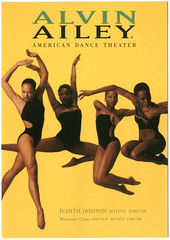
Alvin Ailey American Dance Theater; dir. Judith Jamison (City Center. 2001)
Originally uploaded by Performing Arts / Artes Escénicas
“It doesn’t matter how tired I am,” said Briana Reed, a company member since 1998. “As soon as the music starts, I feel myself transported to another place.”
Ailey’s burning exploration of grief and joy celebrates its 50th anniversary on Wednesday at City Center. As part of the season-long commemoration, the troupe’s artistic director, Judith Jamison, will conduct performances on Friday and Saturday nights. “It’s like a port de bras for me,” she said. “It’s just so easy to breathe with that music.”
Dictators and monarchs and the fine arts
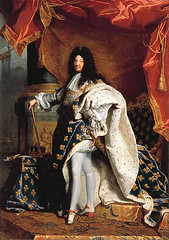
Rigaud, Hyacinthe (1659-1743) - 1701 Louis XIV of France (Louvre, Paris)
Originally uploaded by RasMarley
Please write the Word of the answer.
1. European city, location of the notably naughty Kit Kat Club. ____
2. Approximate era of the story of Cabaret: a) 1890's b) 1930's c)
1940's d) 1960's.
3. Cabaret takes place in the realm of "big-city poverty, drug and
alcohol escapism, criminals, sleazebags, fighting in the streets,
venereal disease, the prostitution of both sexes" and so on. The
French phrase for this non-bourgeois territory translates literally as
"half the world." It is the __ __.
4. "Bourgeois" refers to the values and social place of the a) upper
working class b) upper middle class c) wealthy class.
5. A cabaret is, more or less, a ____.
6. When a person is declining into a state of degeneracy or into the
state of losing their morals we say they are d___ .
7. In 1930's Germany a party called the Nationalist Socialist German
Worker's Party developed in the region around Munich. It was
popularly known as the __ party.
8. Art approved by the government during the Third Reich:
a) modern, abstract, stimulating b) traditional, realistic,
inspirational c) both the above.
9. Attitude toward art by the Third Reich: a) very important b) to be avoided
c) neutral.
10. The residence of Louis XIV and the preceding French kings in
Paris: the Palais du __.
11. The violent rebellion of the impoverished class in la France, the
French Revolution: a) 1689 b) 1718 c) 1776 d) 1789.
12. Southern European nation from which England, Germany and France
derive much of their influence in cuisine, entertainment, government
and art: __ .
13. Vaux le Vicomte: a splendid example of a 17 thcentury French __ .
14. Noblemen won favor with the king in court life at Versailles by
increasing their skill at __ .
15. As a teen, Louis XIV performed as a gilded Apollo in a famous
opera. He thereby acquired the nickname _ __ __, or,in English, _ _ __
.
16. The Greek words khorea,"to dance" and graphein, "to write," are
synthesized in the modern word __ .
17. The river that connects Paris with the North Sea - and the
Atlantic: a) Seine
b) Rhine c) Danube.
18.France is bordered by Italy, Switzerland, Germany, Luxembourg and a) Belgium
b) Netherlands c) Denmark.
19. Name the ancient Chinese-HIndu symbol for Good fortune that was
used by a short-lived European military regime in the late 20th
century: the __ .
20.The German word for Germany: __land.
21. This dancer was born in rural Texas and schooled in Los Angeles.
His creativity, however, flowered in NYC. He was __ __ .
Congrats to Lev Hudson, top scorer on this quiz.
Monday, November 29, 2010
Terminology in ballet is primarily from French
Dance terms in ballet and modern are mostly derived from French, owing to the influence of Louis XIV.
Arabesque [a-ra-BESK] One of the basic poses in ballet, arabesque takes its name from a form of Moorish ornament. In ballet it is a position of the body, in profile, supported on one leg, which can be straight or demi-plié, with the other leg extended behind and at right angles to it, and the arms held in various harmonious positions creating the longest possible line from the fingertips to the toes.
Derrière [deh-RYEHR] Behind, back. This term may refer to a movement, step or placing of a limb in back of the body. In reference to a particular step, the addition of derrière implies that the working foot is closed at the back.
Jeté, grand [grahn zhuh-TAV] Large jeté. In this step the legs are thrown to 90 degrees with a corresponding high jump. It is done forward to attitude croisée or effacée, and to all the arabesques. It may also be done backward with the leg raised either croisé or effacé devant. Grand jeté is always preceded by a preliminary movement such as a glissade.
Pirouette [peer-WET] Whirl or spin. A complete turn of the body on one foot, on point or demi-pointe.
Plié [plee-AY] Bent, bending. A bending of the knee or knees.
Sauté, sautée [soh-TAY] Jumped, jumping.
Arabesque [a-ra-BESK] One of the basic poses in ballet, arabesque takes its name from a form of Moorish ornament. In ballet it is a position of the body, in profile, supported on one leg, which can be straight or demi-plié, with the other leg extended behind and at right angles to it, and the arms held in various harmonious positions creating the longest possible line from the fingertips to the toes.
Derrière [deh-RYEHR] Behind, back. This term may refer to a movement, step or placing of a limb in back of the body. In reference to a particular step, the addition of derrière implies that the working foot is closed at the back.
Jeté, grand [grahn zhuh-TAV] Large jeté. In this step the legs are thrown to 90 degrees with a corresponding high jump. It is done forward to attitude croisée or effacée, and to all the arabesques. It may also be done backward with the leg raised either croisé or effacé devant. Grand jeté is always preceded by a preliminary movement such as a glissade.
Pirouette [peer-WET] Whirl or spin. A complete turn of the body on one foot, on point or demi-pointe.
Plié [plee-AY] Bent, bending. A bending of the knee or knees.
Sauté, sautée [soh-TAY] Jumped, jumping.
Alvin Ailey, Choreographer and Extraordinary American
Alvin Ailey, American modern dancer and choreographer, was born in Rogers, Texas in 1931 and moved to Los Angeles, California at the age of twelve. There, on a junior high school class trip to the Ballet Russe de Monte Carlo, he fell in love with concert dance.
Inspired by performances of the Katherine Dunham Dance Company and classes with Lester Horton, Mr Ailey began his formal dance training. It was with Mr. Horton, the founder of the first racially integrated dance company in this country, that Mr. Ailey embarked on his professional dance career.
After Horton's death in 1953, Mr. Ailey became the director of the Lester Horton Dance Theater and began to choreograph his own works. In 1954, he and his friend Carmen de Lavallade were invited to New York to dance in the Broadway show, House of Flowers, by Truman Capote.
In New York, Mr. Ailey studied with many outstanding dance artists, including Martha Graham, Doris Humphrey and Charles Weidman and took acting classes with Stella Adler. The versatile Ailey won a number of acting roles, continued to choreograph and performed as a dancer.
In 1958, Mr. Ailey founded his own company, the Alvin Ailey American Dance Theater. Mr. Ailey had a vision of creating a company dedicated to the preservation and enrichment of the American modern dance heritage and the uniqueness of black cultural expression. In 1960 he choreographed Revelations, the classic masterpiece of American modern dance based on the religious heritage of his youth.
Throughout his lifetime, Mr. Ailey created some 79 ballets, many of which have appeared in the repertoire of major dance companies, including American Ballet Theatre, The Joffrey Ballet, Dance Theatre of Harlem, Paris Opera Ballet and La Scala Ballet.
Mr. Ailey died of complications due to AIDS on December 1, 1989. Anna Kisselgoff of The New York Times wrote, "You didn't need to have known Ailey personally to have been touched by his humanity, enthusiasm and exuberance and his courageous stand for multiracial brotherhood."
Inspired by performances of the Katherine Dunham Dance Company and classes with Lester Horton, Mr Ailey began his formal dance training. It was with Mr. Horton, the founder of the first racially integrated dance company in this country, that Mr. Ailey embarked on his professional dance career.
After Horton's death in 1953, Mr. Ailey became the director of the Lester Horton Dance Theater and began to choreograph his own works. In 1954, he and his friend Carmen de Lavallade were invited to New York to dance in the Broadway show, House of Flowers, by Truman Capote.
In New York, Mr. Ailey studied with many outstanding dance artists, including Martha Graham, Doris Humphrey and Charles Weidman and took acting classes with Stella Adler. The versatile Ailey won a number of acting roles, continued to choreograph and performed as a dancer.
In 1958, Mr. Ailey founded his own company, the Alvin Ailey American Dance Theater. Mr. Ailey had a vision of creating a company dedicated to the preservation and enrichment of the American modern dance heritage and the uniqueness of black cultural expression. In 1960 he choreographed Revelations, the classic masterpiece of American modern dance based on the religious heritage of his youth.
Throughout his lifetime, Mr. Ailey created some 79 ballets, many of which have appeared in the repertoire of major dance companies, including American Ballet Theatre, The Joffrey Ballet, Dance Theatre of Harlem, Paris Opera Ballet and La Scala Ballet.
Mr. Ailey died of complications due to AIDS on December 1, 1989. Anna Kisselgoff of The New York Times wrote, "You didn't need to have known Ailey personally to have been touched by his humanity, enthusiasm and exuberance and his courageous stand for multiracial brotherhood."
Patron of the Arts in the 1600's: Louis XIV
The Sun King generously financed the royal court, notes Wikipedia, and supported those who worked under him.
He brought the Académie Française under his patronage, and became its "Protector". He allowed Classical French literature to flourish by protecting such writers as Molière, Racine and La Fontaine, whose works remain greatly influential to this day.
Louis also patronised the visual arts by funding and commissioning various artists, such as Charles Le Brun, Pierre Mignard, Antoine Coysevox and Hyacinthe Rigaud whose works became famous throughout Europe. In music, composers and musicians, Lully, Chambonnières and François Couperin thrived and influenced many others.
Through four main building campaigns, Louis converted a hunting lodge built by Louis XIII into the spectacular Palace of Versailles. Louis officially moved the royal court to Versailles on 6 May 1682.
Versailles became a dazzling, awe-inspiring setting for state affairs and the reception of foreign dignitaries. At Versailles, the King alone assumed the attention, which was not shared with the Capital or People.
Several reasons have been suggested for the creation of the extravagant and stately palace, as well as the relocation of the monarchy's seat. For example, Saint-Simon speculated that Louis viewed Versailles as an isolated power center where treasonous cabals could be more readily discovered and foiled.[10] Alternatively, the civil war, le Fronde, caused Louis to allegedly hate Paris, which he abandoned for a country retreat.
However, his many improvements, embellishments and developments of Paris, such as the establishment of a police and street-lighting[11], lend little credence to this theory. As further examples of his continued care for the Capital, Louis constructed the "Hôtel des Invalides"—a military complex and home to this day for officers and soldiers rendered infirm either by injury or age. While pharmacology was still quite rudimentary, les Invalides pioneered new treatments and set new standards for hospice treatment. The conclusion of the Treaty of Aix-la-Chapelle in 1668 also induced Louis to demolish the northern walls of Paris in 1670 and replace them with wide tree-lined boulevards.[12]
Moreover, Louis also renovated and improved the Louvre and many other royal residences.
He brought the Académie Française under his patronage, and became its "Protector". He allowed Classical French literature to flourish by protecting such writers as Molière, Racine and La Fontaine, whose works remain greatly influential to this day.
Louis also patronised the visual arts by funding and commissioning various artists, such as Charles Le Brun, Pierre Mignard, Antoine Coysevox and Hyacinthe Rigaud whose works became famous throughout Europe. In music, composers and musicians, Lully, Chambonnières and François Couperin thrived and influenced many others.
Through four main building campaigns, Louis converted a hunting lodge built by Louis XIII into the spectacular Palace of Versailles. Louis officially moved the royal court to Versailles on 6 May 1682.
Versailles became a dazzling, awe-inspiring setting for state affairs and the reception of foreign dignitaries. At Versailles, the King alone assumed the attention, which was not shared with the Capital or People.
Several reasons have been suggested for the creation of the extravagant and stately palace, as well as the relocation of the monarchy's seat. For example, Saint-Simon speculated that Louis viewed Versailles as an isolated power center where treasonous cabals could be more readily discovered and foiled.[10] Alternatively, the civil war, le Fronde, caused Louis to allegedly hate Paris, which he abandoned for a country retreat.
However, his many improvements, embellishments and developments of Paris, such as the establishment of a police and street-lighting[11], lend little credence to this theory. As further examples of his continued care for the Capital, Louis constructed the "Hôtel des Invalides"—a military complex and home to this day for officers and soldiers rendered infirm either by injury or age. While pharmacology was still quite rudimentary, les Invalides pioneered new treatments and set new standards for hospice treatment. The conclusion of the Treaty of Aix-la-Chapelle in 1668 also induced Louis to demolish the northern walls of Paris in 1670 and replace them with wide tree-lined boulevards.[12]
Moreover, Louis also renovated and improved the Louvre and many other royal residences.
Louis XIV, the Château de Vaux le Vicomte, Versailles and the ballet
When Louis XIV was crowned his interest in dancing was strongly supported and encouraged by Italian-born Cardinal Mazarin, (formerly Mazarini), who assiste Louis XIV. The young king made his ballet debut as a boy, but it was in 1653 as a teenager that he accomplished his most memorable feat as a dancer. He performed a series of dances in Le Ballet de la Nuit and for his final piece he appeared as Apollo, god of the sun. Wearing a fancy golden Roman-cut corselet and a kilt of golden rays he came to be known as the Sun King, says the-ballet.com.
Cardinal Mazarin promoted Italian influences in the French spectacle. The ballet master he imported from Italy was Giovanni Baptista Lulli, who was rechristened Jean Baptiste Lully for work in France. Lully became one of the king's favorite dancers and rivaled the king as the best dancer in France.
In 1661 Louis established the Académie Royale de Danse in a room of the Louvre, the world's first ballet school.
Also in 1661 he attended a party put on by the finance minister to show off his new home in the country. The entertainment was Molière's ballet Les Fâcheaux which pleased the king to no end, although he thought that the finance minister was a treasonous servant. As it turned out, the finance minister was arrested, and the ballet master, the home's architect, and the gardener were hired by the king.
A note on the unlucky minister from Wikipedia -
Once a small château located between the royal residences of Vincennes and Fontainebleau, the estate of Vaux-le-Vicomte was purchased by Nicolas Fouquet in 1641. At that time he was an ambitious twenty-six year-old member of the Parlement of Paris. Fouquet was an avid patron of the arts and attracted many artists with the gifts and encouragements he poured on them.
When Fouquet became King Louis XIV's superintendent of finances (Minister of the Economy, Finance and Industry (France)) in 1657, he commissioned Le Vau, Le Brun and Le Nôtre to renovate his estate and garden to match his grand ambition. Fouquet’s artistic and cultivated personality subsequently brought out the best in the three.[2]
To secure the necessary grounds for the elaborate plans for Vaux-le-Vicomte’s garden and castle, Fouquet purchased and demolished three villages. The displaced villagers were then employed in the upkeep and maintenance of the gardens. It was said to have employed eighteen thousand workers and cost as much as sixteen million livres.[3]
The château and its patron became for a short time a focus for fine feasts, literature and arts. The poet La Fontaine and the playwright Molière were among the artists close to Fouquet. At the inauguration of Vaux-le-Vicomte, a Molière play was performed, along with a dinner event organized by François Vatel, and an impressive firework show.[4]
[edit] Fête and arrest
The château was lavish, refined, and dazzling to behold, but these characteristics proved tragic for its owner: the king had Fouquet arrested shortly after a famous fête that took place on 17 August 1661 where Molière's play 'Les Fâcheux' debuted.[5] The celebration had been too impressive and the superintendent's home too luxurious. Fouquet's intentions were to flatter the King: part of Vaux-le-Vicomte was actually constructed specifically for the king, but Fouquet's plan backfired. - And with the same designers, Louis would create the extraordinary palace of Versailles.
At court, Molière and Lully collaborated, with Molière choreographing and Lully composing the music for ballets. Pierre Beauchamps, another ballet master, also worked with them choreographing interludes in the dramatic parts. Beauchamps eventually was named "superintendent of the king's ballets" in the dance school that Louis established in 1661 and is now one of the most famous of the "fathers" of ballet. It is Beauchamps who has been given credit for standardizing the five foot positions of ballet, (first through fifth positions).
In 1669 Louis, (still Louis XIV), established the Académie Royale de Musique for Lully to run. Then, in 1670 the king, past his physical prime, retired from dancing, allowing other, better dancers to take lead roles.
In 1672 Lully established a dance academy within the Académie Royale de Musique. This dance company survives today as the ballet of the Paris Opera - the world's oldest continuously running ballet company.
Lully's seriousness towards the study of dance led to the development of professional dancers as opposed to courtiers who could dance. Up until 1681 ballet was performed almost exclusively by men. Then, in 1681 Lully staged Le Triomphe de l'Amour, featuring Mademoiselle de Lafontaine, (1665-1738).
In 1687 Lully died from an injury he received by accidentally stabbing his foot with his time marking stick. At this time, ballet was normally performed in the same productions as opera, a theatrical form known as opéra-ballet.
In 1700 Choréographie, ou l'art de décrire la danse was published by Raoul Auger Feuillet. This book wrote down both conventions of stage and ballroom dancing and attempted to create a dance notation similar to music. Although this notation was never finalized and standardized, it is the system that is still in use today as no other system has been developed. The word choréographie gives us the English word choreography and is derived from the greek khorea, (to dance), and graphein, (to write). By 1700 many of the words and movements common in today's ballet were already in use, including jeté, sissone, chassé, entrechat, pirouette, and cabriole.
Cardinal Mazarin promoted Italian influences in the French spectacle. The ballet master he imported from Italy was Giovanni Baptista Lulli, who was rechristened Jean Baptiste Lully for work in France. Lully became one of the king's favorite dancers and rivaled the king as the best dancer in France.
In 1661 Louis established the Académie Royale de Danse in a room of the Louvre, the world's first ballet school.
Also in 1661 he attended a party put on by the finance minister to show off his new home in the country. The entertainment was Molière's ballet Les Fâcheaux which pleased the king to no end, although he thought that the finance minister was a treasonous servant. As it turned out, the finance minister was arrested, and the ballet master, the home's architect, and the gardener were hired by the king.
A note on the unlucky minister from Wikipedia -
Once a small château located between the royal residences of Vincennes and Fontainebleau, the estate of Vaux-le-Vicomte was purchased by Nicolas Fouquet in 1641. At that time he was an ambitious twenty-six year-old member of the Parlement of Paris. Fouquet was an avid patron of the arts and attracted many artists with the gifts and encouragements he poured on them.
When Fouquet became King Louis XIV's superintendent of finances (Minister of the Economy, Finance and Industry (France)) in 1657, he commissioned Le Vau, Le Brun and Le Nôtre to renovate his estate and garden to match his grand ambition. Fouquet’s artistic and cultivated personality subsequently brought out the best in the three.[2]
To secure the necessary grounds for the elaborate plans for Vaux-le-Vicomte’s garden and castle, Fouquet purchased and demolished three villages. The displaced villagers were then employed in the upkeep and maintenance of the gardens. It was said to have employed eighteen thousand workers and cost as much as sixteen million livres.[3]
The château and its patron became for a short time a focus for fine feasts, literature and arts. The poet La Fontaine and the playwright Molière were among the artists close to Fouquet. At the inauguration of Vaux-le-Vicomte, a Molière play was performed, along with a dinner event organized by François Vatel, and an impressive firework show.[4]
[edit] Fête and arrest
The château was lavish, refined, and dazzling to behold, but these characteristics proved tragic for its owner: the king had Fouquet arrested shortly after a famous fête that took place on 17 August 1661 where Molière's play 'Les Fâcheux' debuted.[5] The celebration had been too impressive and the superintendent's home too luxurious. Fouquet's intentions were to flatter the King: part of Vaux-le-Vicomte was actually constructed specifically for the king, but Fouquet's plan backfired. - And with the same designers, Louis would create the extraordinary palace of Versailles.
At court, Molière and Lully collaborated, with Molière choreographing and Lully composing the music for ballets. Pierre Beauchamps, another ballet master, also worked with them choreographing interludes in the dramatic parts. Beauchamps eventually was named "superintendent of the king's ballets" in the dance school that Louis established in 1661 and is now one of the most famous of the "fathers" of ballet. It is Beauchamps who has been given credit for standardizing the five foot positions of ballet, (first through fifth positions).
In 1669 Louis, (still Louis XIV), established the Académie Royale de Musique for Lully to run. Then, in 1670 the king, past his physical prime, retired from dancing, allowing other, better dancers to take lead roles.
In 1672 Lully established a dance academy within the Académie Royale de Musique. This dance company survives today as the ballet of the Paris Opera - the world's oldest continuously running ballet company.
Lully's seriousness towards the study of dance led to the development of professional dancers as opposed to courtiers who could dance. Up until 1681 ballet was performed almost exclusively by men. Then, in 1681 Lully staged Le Triomphe de l'Amour, featuring Mademoiselle de Lafontaine, (1665-1738).
In 1687 Lully died from an injury he received by accidentally stabbing his foot with his time marking stick. At this time, ballet was normally performed in the same productions as opera, a theatrical form known as opéra-ballet.
In 1700 Choréographie, ou l'art de décrire la danse was published by Raoul Auger Feuillet. This book wrote down both conventions of stage and ballroom dancing and attempted to create a dance notation similar to music. Although this notation was never finalized and standardized, it is the system that is still in use today as no other system has been developed. The word choréographie gives us the English word choreography and is derived from the greek khorea, (to dance), and graphein, (to write). By 1700 many of the words and movements common in today's ballet were already in use, including jeté, sissone, chassé, entrechat, pirouette, and cabriole.
Saturday, November 27, 2010
Wednesday, November 17, 2010
Cabaret, the famous movie about decadent life in Berlin, in the Kit Kat Klub
Cabaret is a 1972 American musical film directed by Bob Fosse and starring Liza Minnelli, Michael York and Joel Grey. The film is set in Berlin during the Weimar Republic in 1931, says Wiipedia, under the ominous presence of the growing National Socialist Party.
A female club entertainer in Weimar Republic era Berlin romances two men while the Nazi Party rises to power around them, says IMDB.com.
Sally Bowles, an American singer in 1930s Berlin, fall in love with Brian. They are both seduced by Max, a rich playboy. Sally becomes pregnant, and Brian offers to marry her... All the characters are linked by the Kit-Kat club, a nightspot where Sally sings.
A reviewer wrote, "On a historical level, a personal-story level, and as pure entertainment "Cabaret" works perfectly. The scene is Berlin, Germany, only two years before Hitler would come to total power. It is the Berlin that Christopher Isherwood lived in and wrote about: poverty, drug and alcohol escapism, criminals, sleazebags, fighting in the streets, venereal disease, the prostitution of both sexes, the desperation to escape through the film industry, the temporary escape from the harshness of life in "naughty" nightclubs like The Kit Kat Club, which encapsulates it all. It's a bad scene, and a good example of, perhaps, why so many Germans felt in need of a Hitler. There's not a single verbal reference to Hitler, and yet the presence of the growing Nazi movement all around these decadent misfits is ever present in this film. But you can't blame any of these apolitical people for that. Liza Minelli and Michael York's characters are so needy, so desperate just to find some personal happiness in life. They can't be bothered with what's going on in the bigger picture. Except for the Master Of Ceremonies at the Club: Joel Grey's character is a semi-supernatural all-seeing character, mocking, seeming to somehow know EXACTLY the further destruction Germany's headed for. His scary all-knowing grinning face pops in regularly to remind us."
The movie won 8 Oscars and numerous additional awards in 1973.
A female club entertainer in Weimar Republic era Berlin romances two men while the Nazi Party rises to power around them, says IMDB.com.
Sally Bowles, an American singer in 1930s Berlin, fall in love with Brian. They are both seduced by Max, a rich playboy. Sally becomes pregnant, and Brian offers to marry her... All the characters are linked by the Kit-Kat club, a nightspot where Sally sings.
A reviewer wrote, "On a historical level, a personal-story level, and as pure entertainment "Cabaret" works perfectly. The scene is Berlin, Germany, only two years before Hitler would come to total power. It is the Berlin that Christopher Isherwood lived in and wrote about: poverty, drug and alcohol escapism, criminals, sleazebags, fighting in the streets, venereal disease, the prostitution of both sexes, the desperation to escape through the film industry, the temporary escape from the harshness of life in "naughty" nightclubs like The Kit Kat Club, which encapsulates it all. It's a bad scene, and a good example of, perhaps, why so many Germans felt in need of a Hitler. There's not a single verbal reference to Hitler, and yet the presence of the growing Nazi movement all around these decadent misfits is ever present in this film. But you can't blame any of these apolitical people for that. Liza Minelli and Michael York's characters are so needy, so desperate just to find some personal happiness in life. They can't be bothered with what's going on in the bigger picture. Except for the Master Of Ceremonies at the Club: Joel Grey's character is a semi-supernatural all-seeing character, mocking, seeming to somehow know EXACTLY the further destruction Germany's headed for. His scary all-knowing grinning face pops in regularly to remind us."
The movie won 8 Oscars and numerous additional awards in 1973.
Thursday, November 11, 2010
The colorful interior of Pantheon
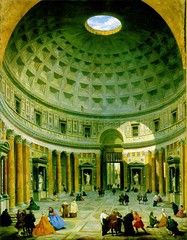
The interior of the Pantheon in the 18th century, painted by Giovanni Paolo Panini.
Originally uploaded by trudeau
See more below.
Paper Pantheon project due Th, Nov 18
Pantheon is from the Greek, meaning "to every god."
- commissioned by Marcus Agrippa as a temple to all the gods of Ancient Rome.
- rebuilt by Emperor Hadrian in about 126 AD.[2]
- portico of three ranks of huge granite Corinthian columns (eight in the first rank and two groups of four behind)
- pediment opening into the rotunda, notes Wikipedia,
- under a coffered, concrete dome
- central opening (oculus) to the sky.
- dome is still the world's largest non-reinforced concrete dome
- height to the oculus and the diameter of the interior circle are the same, 43.3 metres (142 ft).
- It is one of the best preserved of all Roman buildings. It has been in continuous use throughout its history.
- map of Roma
20 pts:
- 5 colored, shaded, cut out and pasted down pantheon w explanatory notes and map of ancient Roma.
- 5 each for the 6 mult-choice questions and profile and signature of 3 respondents.
- due Th, Nov 18.
- commissioned by Marcus Agrippa as a temple to all the gods of Ancient Rome.
- rebuilt by Emperor Hadrian in about 126 AD.[2]
- portico of three ranks of huge granite Corinthian columns (eight in the first rank and two groups of four behind)
- pediment opening into the rotunda, notes Wikipedia,
- under a coffered, concrete dome
- central opening (oculus) to the sky.
- dome is still the world's largest non-reinforced concrete dome
- height to the oculus and the diameter of the interior circle are the same, 43.3 metres (142 ft).
- It is one of the best preserved of all Roman buildings. It has been in continuous use throughout its history.
- map of Roma
20 pts:
- 5 colored, shaded, cut out and pasted down pantheon w explanatory notes and map of ancient Roma.
- 5 each for the 6 mult-choice questions and profile and signature of 3 respondents.
- due Th, Nov 18.
Brief descriptive summary of Macaulay's "Roman City," 12 pts
Open with a scene from the video in writing a brief descriptive summary of Macaulay's "Roman City."
Characters include Lycinus, the Procurator of Gaul (a former slave), Marcus Fabricius, the engineer, and Gaius Valerius, the former general - now the master of the town of Verbona.
3rd person, as always in this class.
Describe the most important scenes and build your summary around those visual passages.
Titling!
Characters include Lycinus, the Procurator of Gaul (a former slave), Marcus Fabricius, the engineer, and Gaius Valerius, the former general - now the master of the town of Verbona.
3rd person, as always in this class.
Describe the most important scenes and build your summary around those visual passages.
Titling!
Wednesday, November 10, 2010
Magnet Fine Arts: the heart of the Roman Empire
The Roman Empire ingested and dispersed the art of the Mediterranean peoples.
Commit this map to thy study!
Venezia
Adriatic Sea
Florence (region of Tuscany), aka Firenze
Roma
- Pantheon
- Forum
- Baths of Trajan
- Basilica
- Temple(s)
- Thermae
Napoli / Bay of Naples
- Isle of Capri
- Vesuvius
- Pompeii
- Herculaneum
Sicily
Tunisia / continent of Africa
Mediterranean
Greece
Peloponnesus peninsula
Crete
Aegean Sea
Asia Minor / Turkey
Istanbul / Constantinople / Byzantium
Black Sea
Diaspora - dispersal / emigration of large group, such as
- Jewish diaspora from Palestine to Europe was partly propelled by Roman occupation.
- Atlantic slave trade
- Native American "Trail of tears" forced diaspora
- Movement of Black Americans from Deep South to Midwest and NE states in early 20th century
Commit this map to thy study!
Venezia
Adriatic Sea
Florence (region of Tuscany), aka Firenze
Roma
- Pantheon
- Forum
- Baths of Trajan
- Basilica
- Temple(s)
- Thermae
Napoli / Bay of Naples
- Isle of Capri
- Vesuvius
- Pompeii
- Herculaneum
Sicily
Tunisia / continent of Africa
Mediterranean
Greece
Peloponnesus peninsula
Crete
Aegean Sea
Asia Minor / Turkey
Istanbul / Constantinople / Byzantium
Black Sea
Diaspora - dispersal / emigration of large group, such as
- Jewish diaspora from Palestine to Europe was partly propelled by Roman occupation.
- Atlantic slave trade
- Native American "Trail of tears" forced diaspora
- Movement of Black Americans from Deep South to Midwest and NE states in early 20th century
Tuesday, November 9, 2010
Insulae, Ostia Antica
In Roman architecture, an insula (Latin for "island," plural insulae) was a kind of apartment building that housed most of the urban citizen population of ancient Rome, says Wikipedia, including ordinary people of lower- or middle-class status (the plebs) and all but the wealthiest from the upper-middle class (the equites).
The traditional elite and the very wealthy lived in domus, large single-family residences, but the two kinds of housing were intermingled in the city and not segregated into separate neighborhoods.[1]
The ground-level floor of the insulae was used for tabernae, shops and businesses, with the living space upstairs. Like modern apartment buildings, an insula might have a name, usually referring to the owner of the building.[2]
The traditional elite and the very wealthy lived in domus, large single-family residences, but the two kinds of housing were intermingled in the city and not segregated into separate neighborhoods.[1]
The ground-level floor of the insulae was used for tabernae, shops and businesses, with the living space upstairs. Like modern apartment buildings, an insula might have a name, usually referring to the owner of the building.[2]
Plaza atrium - Naples
The Latin word atrium referred to the open central court, from which the enclosed rooms led off, in the type of large ancient Roman house known as a domus, says Wikipedia.
The impluvium was the shallow pool sunken into the floor to catch the rainwater. Some surviving examples are beautifully decorated. The opening in the ceiling above the pool called for some means of support for the roof. And it is here where one differentiates between five different styles of atrium.
As the centrepiece of the house the atrium was the most lavishly furnished room. Also, it contained the little chapel to the ancestral spirits (lararium), the household safe (arca) and sometimes a bust of the master of the house.
The term was also used for a variety of spaces in public and religious buildings, mostly forms of arcaded courtyards, larger versions of the domestic spaces. Byzantine churches were often entered through such a space (as are many mosques, though the term is not usually used for Islamic architecture.
The impluvium was the shallow pool sunken into the floor to catch the rainwater. Some surviving examples are beautifully decorated. The opening in the ceiling above the pool called for some means of support for the roof. And it is here where one differentiates between five different styles of atrium.
As the centrepiece of the house the atrium was the most lavishly furnished room. Also, it contained the little chapel to the ancestral spirits (lararium), the household safe (arca) and sometimes a bust of the master of the house.
The term was also used for a variety of spaces in public and religious buildings, mostly forms of arcaded courtyards, larger versions of the domestic spaces. Byzantine churches were often entered through such a space (as are many mosques, though the term is not usually used for Islamic architecture.
Magnet fine arts / Roma: "In vino, veritas."
In vino veritas is a Latin phrase that translates, “in wine [there is the] truth", says Wikipedia.
It is also known as a Greek phrase which has the same meaning. The author of the Latin phrase is Pliny the Elder;[1] the Greek phrase is attributed to the Greek poet Alcaeus.
The Greek poet Alcaeus is the oldest known source for the phrase. The Roman historian Tacitus described how the Germanic peoples always drank wine while holding councils, as they believed nobody could lie effectively when drunk.
The phrase is often continued as, "In vino veritas, in aqua sanitas", i.e., "In wine there is truth, in water there is health."
Similar phrases exist across cultures and languages. In Chinese, there is the saying, "酒後吐真言" ("After wine blurts truthful speech"). The Babylonian Talmud (תלמוד בבלי) contains the passage: "נכנס יין יצא סוד", i.e., "In came wine, out went a secret".[2]
It continues, "בשלשה דברים אדם ניכר בכוסו ובכיסו ובכעסו", i.e., "In three things is a man revealed: in his wine goblet, in his purse, and in his wrath." [3] (In the original Aramaic, the words for "his goblet", "his purse", and "his wrath" rhyme and are a play on words all using the root "כס".)
It is also known as a Greek phrase which has the same meaning. The author of the Latin phrase is Pliny the Elder;[1] the Greek phrase is attributed to the Greek poet Alcaeus.
The Greek poet Alcaeus is the oldest known source for the phrase. The Roman historian Tacitus described how the Germanic peoples always drank wine while holding councils, as they believed nobody could lie effectively when drunk.
The phrase is often continued as, "In vino veritas, in aqua sanitas", i.e., "In wine there is truth, in water there is health."
Similar phrases exist across cultures and languages. In Chinese, there is the saying, "酒後吐真言" ("After wine blurts truthful speech"). The Babylonian Talmud (תלמוד בבלי) contains the passage: "נכנס יין יצא סוד", i.e., "In came wine, out went a secret".[2]
It continues, "בשלשה דברים אדם ניכר בכוסו ובכיסו ובכעסו", i.e., "In three things is a man revealed: in his wine goblet, in his purse, and in his wrath." [3] (In the original Aramaic, the words for "his goblet", "his purse", and "his wrath" rhyme and are a play on words all using the root "כס".)
Monday, November 8, 2010
Quiz at end of viewing David Macaulay's "Roman City"
Fine Arts students may use their won notes on Roman City in the quiz next week on the video.
Ex: Pompeii and the neighboring city of __ .
Ex: Pompeii and the neighboring city of __ .
Roman Empire: ingesting and dispersing the arts of the Mediterranean
From which nations did the Romans absorb artistic material?
Upon which nations did the Romans bestow their artistic models?
Consider their artistic products -
- Temples / to Jupiter, to Bacchus, etc
- Basilicas - center of courts, law
- Forum - center for discussion of issues of the day
- Roads and bridges - carrying goods and artistic design
- Amphitheaters (from the Greek model) / the Colosseum
- Public baths
- City planning - grid
- Stadiums (from the Greek)
- Aqueducts
- Mosaics
- Murals / frescoes
- Roman arch
- Roman tiles
- Toga
- Fountains
- Sculpture
Upon which nations did the Romans bestow their artistic models?
Consider their artistic products -
- Temples / to Jupiter, to Bacchus, etc
- Basilicas - center of courts, law
- Forum - center for discussion of issues of the day
- Roads and bridges - carrying goods and artistic design
- Amphitheaters (from the Greek model) / the Colosseum
- Public baths
- City planning - grid
- Stadiums (from the Greek)
- Aqueducts
- Mosaics
- Murals / frescoes
- Roman arch
- Roman tiles
- Toga
- Fountains
- Sculpture
Thursday, November 4, 2010
Taverna: tastes from the Mediterranean

Taverna: fine arts dishes from the Mediterranean: John's family tabouleh
Originally uploaded by trudeau
The small feast was called a Taverna.
Taverna refers to a small restaurant serving Greek cuisine, notes Wikipedia, not to be confused with "tavern". The Greek word is ταβέρνα and is originally derived from the Latin word taberna ('shed' or 'hut', from tabula 'board', possibly by dissimilation from traberna, from trabs: beam, timber). As Greeks have migrated elsewhere, tavernes (plural) have spread throughout the world, especially countries such as the USA and Australia. The taverna is an integral part of Greek cuisine and of Greek culture.
Bearers of food were awarded 15 pts. Students who did not have dishes may make up to 12 of the points by -
- research and a comparison essay on Aristotle and modern composer-poet John Cage.
- Follow the class essay guidelines.
Jazz dance class on Nov 16, choreography by Escaped Images dancer Tamara Mayer
Choreography by Tamara Mayer, 3rd year dance student at Centenary College, will bring Fine Arts classes to the dance floor on Tues, Nov 16.
Mayer will choose music and create steps for a Charleston-style dance as well as for a flowing modern jazz dance.
Students will rehearse and videotape the fruits of the session.
Mayer will choose music and create steps for a Charleston-style dance as well as for a flowing modern jazz dance.
Students will rehearse and videotape the fruits of the session.
The evolution of Rome from the Republic to the Empire
The Roman Republic was the period of the ancient Roman civilization characterized by a republican form of government.
It began with the overthrow of the Roman monarchy, says Wikipedia, c. 509 BC, and lasted 482 years until its subversion, through a series of civil wars, into the Principate form of government and the Imperial period.
The Roman Republic was governed by a complex constitution, which centered on the principles of a separation of powers and checks and balances. The evolution of the constitution was heavily influenced by the struggle between the aristocracy (the patricians), and other Romans who were not from famous families, the plebeians.
Early in its history, the republic was controlled by an aristocracy of individuals who could trace their ancestry back to the early history of the kingdom. Over time, the laws that allowed these individuals to dominate the government were repealed, and the result was the emergence of a new aristocracy which depended on the structure of society, rather than the law, to maintain its dominance.
During the first two centuries, the Republic saw its territory expand from central Italy to the entire Mediterranean world. In the next century, Rome grew to dominate North Africa, the Iberian Peninsula, Greece, and what is now southern France. During the last two centuries of the Roman Republic, it grew to dominate the rest of modern France, as well as much of the east. At this point, the republican political machinery was replaced with imperialism.
The precise event which signalled the end of the Roman Republic and the transition into the Roman Empire is a matter of interpretation. Towards the end of the period a selection of Roman leaders came to so dominate the political arena that they exceeded the limitations of the Republic as a matter of course. Historians have variously proposed the appointment of Julius Caesar as perpetual dictator in 44 BC, the defeat of Mark Antony at the Battle of Actium in 31 BC, and the Roman Senate's grant of extraordinary powers to Octavian (Augustus) under the first settlement in 27 BC, as candidates for the defining pivotal event ending the Republic.
It began with the overthrow of the Roman monarchy, says Wikipedia, c. 509 BC, and lasted 482 years until its subversion, through a series of civil wars, into the Principate form of government and the Imperial period.
The Roman Republic was governed by a complex constitution, which centered on the principles of a separation of powers and checks and balances. The evolution of the constitution was heavily influenced by the struggle between the aristocracy (the patricians), and other Romans who were not from famous families, the plebeians.
Early in its history, the republic was controlled by an aristocracy of individuals who could trace their ancestry back to the early history of the kingdom. Over time, the laws that allowed these individuals to dominate the government were repealed, and the result was the emergence of a new aristocracy which depended on the structure of society, rather than the law, to maintain its dominance.
During the first two centuries, the Republic saw its territory expand from central Italy to the entire Mediterranean world. In the next century, Rome grew to dominate North Africa, the Iberian Peninsula, Greece, and what is now southern France. During the last two centuries of the Roman Republic, it grew to dominate the rest of modern France, as well as much of the east. At this point, the republican political machinery was replaced with imperialism.
The precise event which signalled the end of the Roman Republic and the transition into the Roman Empire is a matter of interpretation. Towards the end of the period a selection of Roman leaders came to so dominate the political arena that they exceeded the limitations of the Republic as a matter of course. Historians have variously proposed the appointment of Julius Caesar as perpetual dictator in 44 BC, the defeat of Mark Antony at the Battle of Actium in 31 BC, and the Roman Senate's grant of extraordinary powers to Octavian (Augustus) under the first settlement in 27 BC, as candidates for the defining pivotal event ending the Republic.
The bridge from Greece to Rome: the Pantheon in Roma
The Pantheon (from Greek, meaning "to every god") is a building in Rome, commissioned by Marcus Agrippa as a temple to all the gods of Ancient Rome, and rebuilt by Emperor Hadrian in about 126 AD.[2]
The building is circular with a portico of three ranks of huge granite Corinthian columns (eight in the first rank and two groups of four behind) under a pediment opening into the rotunda, notes Wikipedia, under a coffered, concrete dome, with a central opening (oculus) to the sky.
Almost two thousand years after it was built, the Pantheon's dome is still the world's largest non-reinforced concrete dome.[4] The height to the oculus and the diameter of the interior circle are the same, 43.3 metres (142 ft).[5] A rectangular structure links the portico with the rotunda. It is one of the best preserved of all Roman buildings. It has been in continuous use throughout its history, and since the 7th century, the Pantheon has been used as a Roman Catholic church informally known as "Santa Maria Rotonda."[6]
The building is circular with a portico of three ranks of huge granite Corinthian columns (eight in the first rank and two groups of four behind) under a pediment opening into the rotunda, notes Wikipedia, under a coffered, concrete dome, with a central opening (oculus) to the sky.
Almost two thousand years after it was built, the Pantheon's dome is still the world's largest non-reinforced concrete dome.[4] The height to the oculus and the diameter of the interior circle are the same, 43.3 metres (142 ft).[5] A rectangular structure links the portico with the rotunda. It is one of the best preserved of all Roman buildings. It has been in continuous use throughout its history, and since the 7th century, the Pantheon has been used as a Roman Catholic church informally known as "Santa Maria Rotonda."[6]
Wednesday, October 27, 2010
The alpha and omega: the Greek alphabet
The Greek alphabet is a set of twenty-four letters that has been used to write the Greek language since the late 9th or early 8th century BC, says Wikipedia.
It is the first and oldest alphabet in the narrow sense that it notes each vowel and consonant with a separate symbol.[2] It is as such in continuous use to this day. The letters were also used to represent Greek numerals, beginning in the 2nd century BC.
The Greek alphabet is descended from the Phoenician alphabet. It has given rise to many other alphabets used in Europe and the Middle East, including the Latin alphabet.[2]
In addition to being used for writing Modern Greek, its letters are today used as symbols in mathematics and science, as particle names in physics, as components of star names, in the names of fraternities and sororities, in the naming of supernumerary tropical cyclones, and for other purposes.
It is the first and oldest alphabet in the narrow sense that it notes each vowel and consonant with a separate symbol.[2] It is as such in continuous use to this day. The letters were also used to represent Greek numerals, beginning in the 2nd century BC.
The Greek alphabet is descended from the Phoenician alphabet. It has given rise to many other alphabets used in Europe and the Middle East, including the Latin alphabet.[2]
In addition to being used for writing Modern Greek, its letters are today used as symbols in mathematics and science, as particle names in physics, as components of star names, in the names of fraternities and sororities, in the naming of supernumerary tropical cyclones, and for other purposes.
Yeero Yeero, Shreveport
One of several places in Shreveport to visit in exploring cuisine from the Mediterranean, Yeero Yeero is terrifically consistent with its Greek comfort food.
Try it. Try eating inside! Then write about your meal with detailed description and thoughtful evaluation.
Try it. Try eating inside! Then write about your meal with detailed description and thoughtful evaluation.
Tuesday, October 26, 2010
Minoan culture: the wealth and power of Crete preceded the rise of mainland Greece
The Minoans were primarily a mercantile people engaged in overseas trade. Their culture, from 1700 BC onward, shows a high degree of organization, says Wikipedia.
Objects of Minoan manufacture suggest there was a network of trade with mainland Greece (notably Mycenae), Cyprus, Syria, Anatolia, Egypt, Mesopotamia, and westward as far as the coast of Spain.
Minoan men wore loincloths and kilts. Women wore robes that had short sleeves and layered flounced skirts. These were open to the navel allowing their breasts to be left exposed, perhaps during ceremonial occasions.[citation needed] Women also had the option of wearing a strapless fitted bodice, the first fitted garments known in history.[citation needed] The patterns on clothes emphasized symmetrical geometric designs. It must be remembered that other forms of dress may have been worn of which we have no record.
The Minoan religion focused on female deities, with females officiating.[33] The statues of priestesses in Minoan culture and frescoes showing men and women participating in the same sports such as bull-leaping, lead some archaeologists to believe that men and women held equal social status.
Jump to: navigation, search
The Bull-Leaping Fresco from the Great Palace at Knossos, Crete
The bull-leaper, an ivory figurine from the palace of Knossos, Crete. The only complete surviving figure of a larger arrangement of figures. This is the earliest three dimensional representation of the bull leap. It is assumed that thin gold wires were used to suspend the figure over a bull.
Bull-leaping is a motif of Middle Bronze Age figurative art, notably of Minoan Crete, but also found in Hittite Anatolia, the Levant, Bactria and the Indus Valley.[2]
It is often interpreted as a depiction of a ritual performed in connection with bull worship. This ritual consists of an acrobatic leap over a bull; when the leaper grasps the bull's horns, the bull will violently jerk his head upwards giving the leaper the momentum necessary to perform somersaults and other acrobatic tricks or stunts. Bull leaping may have been a rite of passage for young men in Minoan culture.
Objects of Minoan manufacture suggest there was a network of trade with mainland Greece (notably Mycenae), Cyprus, Syria, Anatolia, Egypt, Mesopotamia, and westward as far as the coast of Spain.
Minoan men wore loincloths and kilts. Women wore robes that had short sleeves and layered flounced skirts. These were open to the navel allowing their breasts to be left exposed, perhaps during ceremonial occasions.[citation needed] Women also had the option of wearing a strapless fitted bodice, the first fitted garments known in history.[citation needed] The patterns on clothes emphasized symmetrical geometric designs. It must be remembered that other forms of dress may have been worn of which we have no record.
The Minoan religion focused on female deities, with females officiating.[33] The statues of priestesses in Minoan culture and frescoes showing men and women participating in the same sports such as bull-leaping, lead some archaeologists to believe that men and women held equal social status.
Jump to: navigation, search
The Bull-Leaping Fresco from the Great Palace at Knossos, Crete
The bull-leaper, an ivory figurine from the palace of Knossos, Crete. The only complete surviving figure of a larger arrangement of figures. This is the earliest three dimensional representation of the bull leap. It is assumed that thin gold wires were used to suspend the figure over a bull.
Bull-leaping is a motif of Middle Bronze Age figurative art, notably of Minoan Crete, but also found in Hittite Anatolia, the Levant, Bactria and the Indus Valley.[2]
It is often interpreted as a depiction of a ritual performed in connection with bull worship. This ritual consists of an acrobatic leap over a bull; when the leaper grasps the bull's horns, the bull will violently jerk his head upwards giving the leaper the momentum necessary to perform somersaults and other acrobatic tricks or stunts. Bull leaping may have been a rite of passage for young men in Minoan culture.
A modern plot from an Archaic Greek playwright, Aristophanes
A brief summary of the cynical playwright Aristophanes' play, The Clouds:
Faced with legal action for non-payment of debts, Strepsiades, an elderly Athenian, enrolls his son in The Thinkery (the "Phrontisterion") so that he might learn the rhetorical skills necessary to defeat their creditors in court. The son thereby learns cynical disrespect for social mores and contempt for authority and he subsequently beats his father up during a domestic argument, in return for which Strepsiades sets The Thinkery on fire.
It was a satire at the expense of Socrates and was, said some, damaging to Socrates reputation.
Faced with legal action for non-payment of debts, Strepsiades, an elderly Athenian, enrolls his son in The Thinkery (the "Phrontisterion") so that he might learn the rhetorical skills necessary to defeat their creditors in court. The son thereby learns cynical disrespect for social mores and contempt for authority and he subsequently beats his father up during a domestic argument, in return for which Strepsiades sets The Thinkery on fire.
It was a satire at the expense of Socrates and was, said some, damaging to Socrates reputation.
Thursday, October 21, 2010
Taverna! A Greek meze upon the lawn - with guests! Th, Nov 4
The Greek Taverna picnic.
Changed to Thurs. a week! Nov 4.
Everyone must do something creative.
15 pts; not bonus or indie work.
Dishes may be made by more than one person.
The principal needs include
- hummus dip
- tzatziki dip
- dolmas (dolmades)
- mint tea
- pita bread
- olives
- olive oil
- feta cheese
- Greek salat (onions, lettuce, olives, etc)
- baba ghanoush dip
- moussaka (sim to lasagna)
- patitsio (sim to lasagna)
- baklava
- souvlaki (shish kebab)
- spanikopita (spinach pie)
- panini
- yogurt (natural flavor) with honey
- herbed, buttered boiled potato bites
- koulourakia - butter cookies w almonds
- espresso
- signage - to briefly explain each dish
- folk music - epics and tunes about Homer & the Odyssey
- paper plates, plastic forks supplied by the teacher.
More info: begin with wikipedia at Greek Cuisine.
Changed to Thurs. a week! Nov 4.
Everyone must do something creative.
15 pts; not bonus or indie work.
Dishes may be made by more than one person.
The principal needs include
- hummus dip
- tzatziki dip
- dolmas (dolmades)
- mint tea
- pita bread
- olives
- olive oil
- feta cheese
- Greek salat (onions, lettuce, olives, etc)
- baba ghanoush dip
- moussaka (sim to lasagna)
- patitsio (sim to lasagna)
- baklava
- souvlaki (shish kebab)
- spanikopita (spinach pie)
- panini
- yogurt (natural flavor) with honey
- herbed, buttered boiled potato bites
- koulourakia - butter cookies w almonds
- espresso
- signage - to briefly explain each dish
- folk music - epics and tunes about Homer & the Odyssey
- paper plates, plastic forks supplied by the teacher.
More info: begin with wikipedia at Greek Cuisine.
Art in nature: the importance of the Mediterranean tree called the Olive
The olive is one of the plants most often cited in literature. In Homer's Odyssey, Odysseus crawls beneath two shoots of olive that grow from a single stock,[4] and in the Iliad, (XVII.53ff) is a metaphoric description of a lone olive tree in the mountains, by a spring; the Greeks observed that the olive rarely thrives at a distance from the sea, which in Greece invariably means up mountain slopes.
Greek myth attributed to the primordial culture-hero Aristaeus the understanding of olive husbandry, along with cheese-making and bee-keeping.[5] Olive was one of the woods used to fashion the most primitive Greek cult figures, called xoana, referring to their wooden material; they were reverently preserved for centuries.[6] It was purely a matter of local pride that the Athenians claimed that the olive grew first in Athens.[7] In an archaic Athenian foundation myth, Athena won the patronship of Attica from Poseidon with the gift of the olive.
The leafy branches of the olive tree - the olive leaf as a symbol of abundance, glory and peace - were used to crown the victors of friendly games and bloody wars. As emblems of benediction and purification, they were also ritually offered to deities and powerful figures; some were even found in Tutankhamen's tomb.
Olive oil has long been considered sacred; it was used to anoint kings and athletes in ancient Greece. It was burnt in the sacred lamps of temples as well as being the "eternal flame" of the original Olympic Games. Victors in these games were crowned with its leaves.
Over the years, the olive has been the symbol of peace, wisdom, glory, fertility, power and pureness. The olive tree and olives are mentioned over 30 times in the Bible, in both the New and Old Testaments. It is one of the first plants mentioned in the Bible, and one of the most significant. For example, it was an olive leaf that a dove brought back to Noah to demonstrate that the flood was over.
The olive tree and olive oil are mentioned seven times in the Quran, and the olive is praised as a precious fruit. In Chapter 24 Al-Nur: "Allah is the Light of the heavens and the earth. The metaphor of His Light is that of a niche in which is a lamp, the lamp inside a glass, the glass like a brilliant star, lit from a blessed tree, an olive, neither of the east nor of the west, its oil all but giving off light even if no fire touches it. Light upon Light. Allah guides to His Light whoever He wills and Allah makes metaphors for mankind and Allah has knowledge of all things." (Quran, 24:35). Olive tree and olive oil health benefits have been propounded in Prophetic medicine. The Prophet Mohamed is reported to have said: "Take oil of olive and massage with it - it is a blessed tree" (Sunan al-Darimi, 69:103).
It is estimated the cultivation of olive trees began more than 7000 years ago. As far back as 3000 BC, olives were grown commercially in Crete; they may have been the source of the wealth of the Minoan civilization.[14] The ancient Greeks used to smear olive oil on their bodies and hair as a matter of grooming and good health.
Greek myth attributed to the primordial culture-hero Aristaeus the understanding of olive husbandry, along with cheese-making and bee-keeping.[5] Olive was one of the woods used to fashion the most primitive Greek cult figures, called xoana, referring to their wooden material; they were reverently preserved for centuries.[6] It was purely a matter of local pride that the Athenians claimed that the olive grew first in Athens.[7] In an archaic Athenian foundation myth, Athena won the patronship of Attica from Poseidon with the gift of the olive.
The leafy branches of the olive tree - the olive leaf as a symbol of abundance, glory and peace - were used to crown the victors of friendly games and bloody wars. As emblems of benediction and purification, they were also ritually offered to deities and powerful figures; some were even found in Tutankhamen's tomb.
Olive oil has long been considered sacred; it was used to anoint kings and athletes in ancient Greece. It was burnt in the sacred lamps of temples as well as being the "eternal flame" of the original Olympic Games. Victors in these games were crowned with its leaves.
Over the years, the olive has been the symbol of peace, wisdom, glory, fertility, power and pureness. The olive tree and olives are mentioned over 30 times in the Bible, in both the New and Old Testaments. It is one of the first plants mentioned in the Bible, and one of the most significant. For example, it was an olive leaf that a dove brought back to Noah to demonstrate that the flood was over.
The olive tree and olive oil are mentioned seven times in the Quran, and the olive is praised as a precious fruit. In Chapter 24 Al-Nur: "Allah is the Light of the heavens and the earth. The metaphor of His Light is that of a niche in which is a lamp, the lamp inside a glass, the glass like a brilliant star, lit from a blessed tree, an olive, neither of the east nor of the west, its oil all but giving off light even if no fire touches it. Light upon Light. Allah guides to His Light whoever He wills and Allah makes metaphors for mankind and Allah has knowledge of all things." (Quran, 24:35). Olive tree and olive oil health benefits have been propounded in Prophetic medicine. The Prophet Mohamed is reported to have said: "Take oil of olive and massage with it - it is a blessed tree" (Sunan al-Darimi, 69:103).
It is estimated the cultivation of olive trees began more than 7000 years ago. As far back as 3000 BC, olives were grown commercially in Crete; they may have been the source of the wealth of the Minoan civilization.[14] The ancient Greeks used to smear olive oil on their bodies and hair as a matter of grooming and good health.
Wednesday, October 20, 2010
Karpeles Manuscript Library Museum / Shreveport
Your once-a-month Fine Arts Experience papers - at 12 pts each - can be written about a wide range of topics -
- a meal at an ethnic, independent restaurant (please check w me)
- an indie movie (low budget, non mass-market, artistic in direction), preferably at Robinson Film Center.
- performance of a drama or comedy or musical.
- concert by an orchestra or opera troupe.
- concert by a non mass-market, artistic pop unit.
- visit to a museum or gallery featuring artistic displays (any museum in town, from a repeat visit to Norton to the La State Exhibit Museum).
The theme is to get out of your usual pathway and experience the artistic offerings that enrich life in an urban center.
You must follow the review guidelines posted at fineartsmagnet.blogspot.com. To write from the top of your head does not represent growth in the skill of composition. Find and follow the class guidelines.
- a meal at an ethnic, independent restaurant (please check w me)
- an indie movie (low budget, non mass-market, artistic in direction), preferably at Robinson Film Center.
- performance of a drama or comedy or musical.
- concert by an orchestra or opera troupe.
- concert by a non mass-market, artistic pop unit.
- visit to a museum or gallery featuring artistic displays (any museum in town, from a repeat visit to Norton to the La State Exhibit Museum).
The theme is to get out of your usual pathway and experience the artistic offerings that enrich life in an urban center.
You must follow the review guidelines posted at fineartsmagnet.blogspot.com. To write from the top of your head does not represent growth in the skill of composition. Find and follow the class guidelines.
Tuesday, October 19, 2010
Mult-choice, open notes quiz on Greece and Egypt first block Oct 26-27
A quiz of around 21 questions will review web site notes on both Egypt and Greece.
Web site notes through Sat, Oct 23.
Web site notes through Sat, Oct 23.
Topics in historic Greek art for a basic digital image-based report
Please present the basics on each topic via 5 images -, each w 2 or 3 bulleted items of info. Due a week from today. 10 pts.
1. Crete
2. Mycenae
3. Sparta
4. Olympia
5. Olympic games
6. Archaic period
7. Classic period
8. Athens
9. Pericles
10. Homer
11. Sappho
12. symposium
13. Academy & Lyceum
14. Socrates
15. Plato
16. Aristotle
17. Sophists
18. Epicureans
19. Stoics
20. Greek drama
21. Greek amphitheater & stage
22. Herodotus
23. Aristophanes
24. Sophocles
25. Aristophanes
26. tragedy & comedy
27. Aesclepius
28. Alexander the Great
29. Hellenistic era
30. Roman empire / Greece
31. Greek Orthodox Church
32. Byzantine Empire
33. Greek cuisine
1. Crete
2. Mycenae
3. Sparta
4. Olympia
5. Olympic games
6. Archaic period
7. Classic period
8. Athens
9. Pericles
10. Homer
11. Sappho
12. symposium
13. Academy & Lyceum
14. Socrates
15. Plato
16. Aristotle
17. Sophists
18. Epicureans
19. Stoics
20. Greek drama
21. Greek amphitheater & stage
22. Herodotus
23. Aristophanes
24. Sophocles
25. Aristophanes
26. tragedy & comedy
27. Aesclepius
28. Alexander the Great
29. Hellenistic era
30. Roman empire / Greece
31. Greek Orthodox Church
32. Byzantine Empire
33. Greek cuisine
Sunday, October 17, 2010
Vocal power and kinetic verve: Shreveport Little Theater Academy's production of Rent
Isaac Haas, in profile, threw his large eyes upon Erin Davis, petite but also large of eyes. Their melodies alternated - both have strong, sweet voices - and then blended into a melodious cat's howl.
It was the Shreveport Little Theater Academy's production of Rent on Saturday night, where expressions exploded and the singing was super.
Director Jared Watson has taken a group of talented and handsome teens, found their strengths and cast them like butter into a sautee pan.
Zhailon Levingston threw himself around the stage and molded his rich voice to numerous melodies. Gentry Williams, too, beamed and crooned with capable abandon.
Anchoring the stage with a voice so righteous it rolls effortlessly from blues to opera was Emily Mwakitawa. Following in her vocal footsteps were Emma Foreman and Wallace Rakoczy, both passionate young wailers.
Kaelon Gerard, a tall lad with thick vocal timbre, was, like all the principals, able to trippingly dance across the stage while hitting his notes.
Yet a major component was missing from this version of Rent: no band. The excellent ensemble that SLTA has used under music director Adam Philley was caught in a schedule conflict, explained director Watson.
What a shame, not to pick up a substitute group of musicians!
Rent is a not an easy show for a teen cast. It's a story of poverty, prostitution, hard drugs, death - and life before texting. Rent also has a complex storyline. Reading the outline before seeing the show would not be a waste of time.
Teens want a show that reflects their striving for independence. Watson explained that, "This is the show these kids really wanted to do." And if there's a full measure of raunch, there's also a positive side to Rent: it glorifies friendship, loyalty, community and endurance.
In the end, this production of Rent is notable for vocal power and kinetic entertainment.
Even without live music it offers a worthy evening of entertainment.
It was the Shreveport Little Theater Academy's production of Rent on Saturday night, where expressions exploded and the singing was super.
Director Jared Watson has taken a group of talented and handsome teens, found their strengths and cast them like butter into a sautee pan.
Zhailon Levingston threw himself around the stage and molded his rich voice to numerous melodies. Gentry Williams, too, beamed and crooned with capable abandon.
Anchoring the stage with a voice so righteous it rolls effortlessly from blues to opera was Emily Mwakitawa. Following in her vocal footsteps were Emma Foreman and Wallace Rakoczy, both passionate young wailers.
Kaelon Gerard, a tall lad with thick vocal timbre, was, like all the principals, able to trippingly dance across the stage while hitting his notes.
Yet a major component was missing from this version of Rent: no band. The excellent ensemble that SLTA has used under music director Adam Philley was caught in a schedule conflict, explained director Watson.
What a shame, not to pick up a substitute group of musicians!
Rent is a not an easy show for a teen cast. It's a story of poverty, prostitution, hard drugs, death - and life before texting. Rent also has a complex storyline. Reading the outline before seeing the show would not be a waste of time.
Teens want a show that reflects their striving for independence. Watson explained that, "This is the show these kids really wanted to do." And if there's a full measure of raunch, there's also a positive side to Rent: it glorifies friendship, loyalty, community and endurance.
In the end, this production of Rent is notable for vocal power and kinetic entertainment.
Even without live music it offers a worthy evening of entertainment.
Thursday, October 14, 2010
Ethnocentrism and the Swastika
This swastika is on a house in Jamalpur, Bihar, India, writes the photographer. The swastika is an ancient symbol representing permanent spiritual victory.
The photojournalist continues, "I have seen so many swastikas here in India - on temples, houses, shops, rickshaws and in random, unexpected places - that they just seem very commonplace to me now. This is very far from the shocking reaction that the symbol often receives in the West, due to the history of its abuse there. That negative perception is absolutely absent from people's minds here. The swastika here represents goodness, righteousness, truth, purpose and divinity."
Somehow your teacher is going to leap from the swastika to ethnocentrism.
Ethnocentrism is the tendency to believe that one's ethnic or cultural group is centrally important, and that all other groups are measured in relation to one's own.
People of the following nations are known for their ethnocentrism:
Americans
French
Italians
Russians
Chinese
One form of ethnocentrism is nationalism. A certain amount of nationalism is considered healthy. Radical nationalism may be barbarous.
When Americans judge the swastika to be a symbol of evil Nazi corruption, are they being ethnocentric? No. They're simply showing their lack of education.
The photojournalist continues, "I have seen so many swastikas here in India - on temples, houses, shops, rickshaws and in random, unexpected places - that they just seem very commonplace to me now. This is very far from the shocking reaction that the symbol often receives in the West, due to the history of its abuse there. That negative perception is absolutely absent from people's minds here. The swastika here represents goodness, righteousness, truth, purpose and divinity."
Somehow your teacher is going to leap from the swastika to ethnocentrism.
Ethnocentrism is the tendency to believe that one's ethnic or cultural group is centrally important, and that all other groups are measured in relation to one's own.
People of the following nations are known for their ethnocentrism:
Americans
French
Italians
Russians
Chinese
One form of ethnocentrism is nationalism. A certain amount of nationalism is considered healthy. Radical nationalism may be barbarous.
When Americans judge the swastika to be a symbol of evil Nazi corruption, are they being ethnocentric? No. They're simply showing their lack of education.
Riace bronzes, classic Greek sculpture, displayed in the Reggio Calabria Museum of Italy
Most Greek sculpture is known through later Roman copies in marble.
The Riace bronzes are original, says Wikipedia.
The statues' eyes are inlaid with bone and glass, while the teeth are in silver and lips and nipples are in copper. Formerly they held spears and shields. Additionally, Riace Warrior B once wore a helmet pushed up atop his head, and it is thought that Riace Warrior A perhaps wore a wreath over his.[3] The Bronzi, outstanding examples of ancient Greek sculpture, belong to a transitional period from archaic Greek sculpture to the early Classic style, disguising their idealized geometry and impossible anatomy (Spivey 2005) under a distracting and alluring "realistic" surface.
These bronzes are from the early Classical Period, made about 445 BCE. They are a fine example of contrapposto - the weight is on the back legs and is much more realistic than Archaic stances. The musculature is clear yet not incised and looks soft enough to be visible yet realistic. The turned head not only represents movement but also adds life to the sculptures. The asymmetrical layout of the arms and legs serves to add to the realism.
The Riace bronzes are original, says Wikipedia.
The statues' eyes are inlaid with bone and glass, while the teeth are in silver and lips and nipples are in copper. Formerly they held spears and shields. Additionally, Riace Warrior B once wore a helmet pushed up atop his head, and it is thought that Riace Warrior A perhaps wore a wreath over his.[3] The Bronzi, outstanding examples of ancient Greek sculpture, belong to a transitional period from archaic Greek sculpture to the early Classic style, disguising their idealized geometry and impossible anatomy (Spivey 2005) under a distracting and alluring "realistic" surface.
These bronzes are from the early Classical Period, made about 445 BCE. They are a fine example of contrapposto - the weight is on the back legs and is much more realistic than Archaic stances. The musculature is clear yet not incised and looks soft enough to be visible yet realistic. The turned head not only represents movement but also adds life to the sculptures. The asymmetrical layout of the arms and legs serves to add to the realism.
Spartans, the militaristic city-state that won the Peloponnesian Wars
Sparta, the great military state, was recognized as the overall leader of the combined Greek forces during the Greco-Persian Wars.[2], says Wikipedia.
Between 431 and 404 BC, Sparta was the principal enemy of Athens during the Peloponnesian War,[3] from which it emerged victorious, though at great cost.
Sparta maintained its political independence until 146 BC, when the Romans conquered Greece.
Sparta was unique in ancient Greece for its social system and constitution, which completely focused on military training and excellence.
Its inhabitants were classified as Spartiates (Spartan citizens, who enjoyed full rights), Mothakes (non-Spartan free men raised as Spartans), Perioikoi (freedmen), and Helots (state-owned serfs, enslaved non-Spartan local population). Spartiates underwent the rigorous agoge training and education regimen, and Spartan phalanxes were widely considered to be among the best in battle. Spartan women enjoyed considerably more rights and equality to men than elsewhere in the classical world.
The Spartans were a minority of the Lakonian population. The largest class of inhabitants were the helots (in Classical Greek Εἵλωτες / Heílôtes).[32][33]
The helots were originally free Greeks from the areas of Messenia and Lakonia whom the Spartans had defeated in battle and subsequently enslaved. In other Greek city-states, free citizens were part-time soldiers who, when not at war, carried on other trades. Since Spartan men were full-time soldiers, they were not available to carry out manual labour.[34] The helots were used as unskilled serfs, tilling Spartan land. Helot women were often used as wet nurses. Helots also travelled with the Spartan army as non-combatant serfs.
When male Spartans began military training at age seven, they would enter the Agoge system. The Agoge was designed to encourage discipline and physical toughness and to emphasise the importance of the Spartan state. Boys lived in communal messes and were deliberately underfed, to encourage them to master the skill of stealing food. Besides physical and weapons training, boys studied reading, writing, music and dancing. Special punishments were imposed if boys failed to answer questions sufficiently 'laconically' (i.e. briefly and wittily).[55] At the age of twelve, the Agoge obliged Spartan boys to take an older male mentor, usually an unmarried young man. The older man was expected to function as a kind of substitute father and role model to his junior partner; however, it is also reasonably certain that they had sexual relations (the exact nature of Spartan pederasty is not entirely clear).[56]
The pattern above is the famous Greek Key. It is often seen in friezes and other borders.
Between 431 and 404 BC, Sparta was the principal enemy of Athens during the Peloponnesian War,[3] from which it emerged victorious, though at great cost.
Sparta maintained its political independence until 146 BC, when the Romans conquered Greece.
Sparta was unique in ancient Greece for its social system and constitution, which completely focused on military training and excellence.
Its inhabitants were classified as Spartiates (Spartan citizens, who enjoyed full rights), Mothakes (non-Spartan free men raised as Spartans), Perioikoi (freedmen), and Helots (state-owned serfs, enslaved non-Spartan local population). Spartiates underwent the rigorous agoge training and education regimen, and Spartan phalanxes were widely considered to be among the best in battle. Spartan women enjoyed considerably more rights and equality to men than elsewhere in the classical world.
The Spartans were a minority of the Lakonian population. The largest class of inhabitants were the helots (in Classical Greek Εἵλωτες / Heílôtes).[32][33]
The helots were originally free Greeks from the areas of Messenia and Lakonia whom the Spartans had defeated in battle and subsequently enslaved. In other Greek city-states, free citizens were part-time soldiers who, when not at war, carried on other trades. Since Spartan men were full-time soldiers, they were not available to carry out manual labour.[34] The helots were used as unskilled serfs, tilling Spartan land. Helot women were often used as wet nurses. Helots also travelled with the Spartan army as non-combatant serfs.
When male Spartans began military training at age seven, they would enter the Agoge system. The Agoge was designed to encourage discipline and physical toughness and to emphasise the importance of the Spartan state. Boys lived in communal messes and were deliberately underfed, to encourage them to master the skill of stealing food. Besides physical and weapons training, boys studied reading, writing, music and dancing. Special punishments were imposed if boys failed to answer questions sufficiently 'laconically' (i.e. briefly and wittily).[55] At the age of twelve, the Agoge obliged Spartan boys to take an older male mentor, usually an unmarried young man. The older man was expected to function as a kind of substitute father and role model to his junior partner; however, it is also reasonably certain that they had sexual relations (the exact nature of Spartan pederasty is not entirely clear).[56]
The pattern above is the famous Greek Key. It is often seen in friezes and other borders.
Tuesday, October 12, 2010
The Paper Parthenon atop the Acropolis
Grecian art, or Hellenistic art -
Greek excellence in architecture has touched the world in the almost 3 centuries following their 450 BCE Golden Era.
Pericles was sort of their George Washington. Pericles led the Athenians in military success, in trading at sea and directed the building of the Parthenon.
The temple of Athena Parthenos (parthenogenesis, "virgin birth")
is the largest of numerous temples atop the mesa called the Acropolis (acro, "high," see acrophobia, "fear of heights"). It is one of the few great cities named for a goddess.
The Doric columns (Ionic and Corinthian columns are more elaborate)
are topped by a decorative band called a frieze. Above the frieze is the pediment, which represents the footing of the roof.
Inside was a 40-foot ivory and gold statue of Athena.
The relief sculptures in the pediment brought to life the struggle of Athena and Poseidon. Those marble sculptures now reside in the British Museum, London (and are referred to as the Elgin Marbles). The Greeks are asking that the work be repatriated - brought back to its fatherland. So far the English government has demurred.
Students are using rolled paper columns and thick pediments and frieze to bring the Parthenon to life with unusual texture.
The project, with identifications of all parts and a map of the Greek Empire, is worth 5 points.
Students will also write a 9-question, multiple-choice quiz to cover the terminology.
Before the end of next week they must teach the lesson of the Parthenon to 3 people.
- Record their answers and the score.
- Have the pupil sign and write a brief profile, such as "Brian Beeler, age 45, electrician."
- Quiz and 3 sets of results: 15 pts.
The educational theme: "if you want to learn a thing, teach it."
Greek excellence in architecture has touched the world in the almost 3 centuries following their 450 BCE Golden Era.
Pericles was sort of their George Washington. Pericles led the Athenians in military success, in trading at sea and directed the building of the Parthenon.
The temple of Athena Parthenos (parthenogenesis, "virgin birth")
is the largest of numerous temples atop the mesa called the Acropolis (acro, "high," see acrophobia, "fear of heights"). It is one of the few great cities named for a goddess.
The Doric columns (Ionic and Corinthian columns are more elaborate)
are topped by a decorative band called a frieze. Above the frieze is the pediment, which represents the footing of the roof.
Inside was a 40-foot ivory and gold statue of Athena.
The relief sculptures in the pediment brought to life the struggle of Athena and Poseidon. Those marble sculptures now reside in the British Museum, London (and are referred to as the Elgin Marbles). The Greeks are asking that the work be repatriated - brought back to its fatherland. So far the English government has demurred.
Students are using rolled paper columns and thick pediments and frieze to bring the Parthenon to life with unusual texture.
The project, with identifications of all parts and a map of the Greek Empire, is worth 5 points.
Students will also write a 9-question, multiple-choice quiz to cover the terminology.
Before the end of next week they must teach the lesson of the Parthenon to 3 people.
- Record their answers and the score.
- Have the pupil sign and write a brief profile, such as "Brian Beeler, age 45, electrician."
- Quiz and 3 sets of results: 15 pts.
The educational theme: "if you want to learn a thing, teach it."
Subscribe to:
Posts (Atom)

